A passion for change and innovation
Career changers find passion for teaching with in-school training

Learning in a virtual world delivers safer drivers
Bringing local pūrakau to life on stage

Career changers find passion for teaching with in-school training

Learning in a virtual world delivers safer drivers
Bringing local pūrakau to life on stage
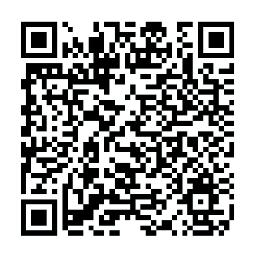





It’s never been easier or more affordable to support reading and literacy goals with ebooks and audiobooks. For a low annual fee of $1,500 NZD, your students and educators will have anytime access to a curated collection of over 1,000 ebooks and audiobooks. And it’s all available through the award-winning Sora student reading app, which can be navigated in Maori.
Offered by OverDrive, the leading platform for digital content delivered to 88,000 schools and libraries worldwide.
Ѧ Margaret Mahy
Ѧ Bren MacDibble
Ѧ Trina Saffioti
Ѧ Courtney Sina Meredith
OVERDRIVE OFFERS TITLES FROM AUTHORS INCLUDING:


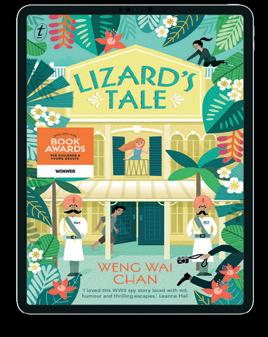




Ѧ Whiti Hereaka
Ѧ Leonie Agnew
Ѧ Joy Cowley
Ѧ Kate De Goldi
Ѧ Maurice Gee
Ѧ Juliette Maciver
Ѧ Anh Do
Ѧ Aaron Blabey
Ѧ Meredith Costain
Ѧ Jeff Kinney
Ѧ Dav Pilkey


Ѧ J.K. Rowling
And students can also access age-appropriate ebooks and audiobooks from their local public library with Sora’s built-in Public Library CONNECT feature – for even more to read.
company.overdrive.com/ebooks-now/au/ schools@overdrive.com






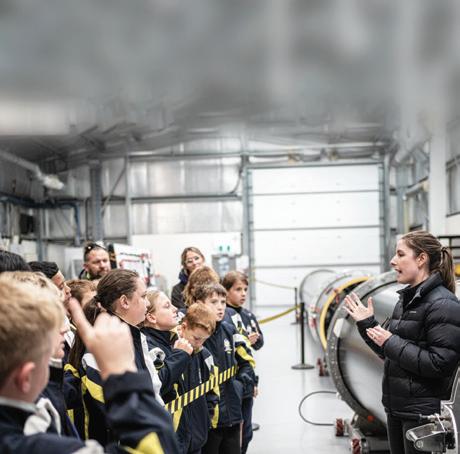
Read each new edition before it’s in print by subscribing to the Tukutuku Kōrero | Education Gazette newsletter. You will get the latest content straight to your inbox, including bonus online articles, videos and podcasts.
To view the PLD, general notice listings and vacancies at gazette.education.govt.nz
Scan the QR codes with the camera on your device.
PUBLISHED BY
Education Gazette is published for the Ministry of Education by NZME. Educational Media Ltd. PO Box 200, Wellington.
ISSN 2815-8415 (Print)
ISSN 2815-8423 (Online)
All advertising is subject to advertisers agreeing to NZME. Advertising terms and conditions www.nzme.co.nz/ media/1522/nzme-advertisingterms-sept-2020.pdf
STORY IDEAS
We welcome your story ideas. Please email a brief (50-100 words) outline to: gazette@education.govt.nz
SUBSCRIPTIONS
eleni.hilder@nzme.co.nz
VIEW US ONLINE Web: gazette.education.govt.nz
Instagram: @edgazettenz Youtube: youtube.com/ edgazettenewzealand
PLD
KEY CONTACTS
Reporter gazette@education.govt.nz
Display & paid advertising
Jill Parker 027 212 9277 jill.parker@nzme.co.nz
Vacancies & notices listings
Eleni Hilder 04 915 9796 vacancies@edgazette.govt.nz notices@edgazette.govt.nz
DEADLINES
The deadline for display advertising to be printed in the 28 August 2023 edition of Education Gazette is 4pm on Friday 11 August 2023.
Much of this edition focuses on bringing learning to life for ākonga – textbooks, curriculum documents and lesson plans transcending the page to become something more meaningful, and real.
We see this through the arts, through practical applications of STEM, and through ever-evolving technology such as artificial intelligence, virtual reality, and augmented reality. And, of course, this is best delivered by kaiako who are passionate, skilled, supported, and ever-evolving themselves. This is what you will see in this edition.
Read about career changers using successful in-school training programmes to transfer their passion for theatre, science, communications, food, business and more, into the classroom and to the next generation.
Read about how virtual reality and AI is bringing learning to life – such as in driver education or Aotearoa New Zealand’s histories. Read how visual arts and performance arts are doing the same, while also building self-esteem and important relationship skills.
We have real-life learning. We have a skilled workforce. And, just as important, we also recognise ways to respond to ākonga identity and aspirations in a culturally sustaining way. Responding to identity, language and culture is the key to ākonga being present, participating and progressing in their learning. Read about the role of a cultural diversity facilitator, the uniqueness of boys’ schools in Aotearoa and in a global context, and kaiako finding their own sense of belonging and engagement within their wider networks and kāhui ako.
I hope you can read each thread and see how we weave together the story of learning in Aotearoa, and perhaps, where your own practice links in.
Whiria te tāngata.
Weave the people together.
Kia maiea te rā, nā
Sarah Wilson Ētita | Editor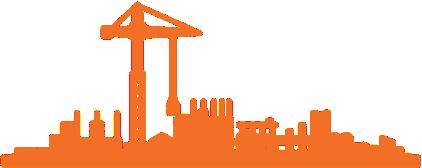

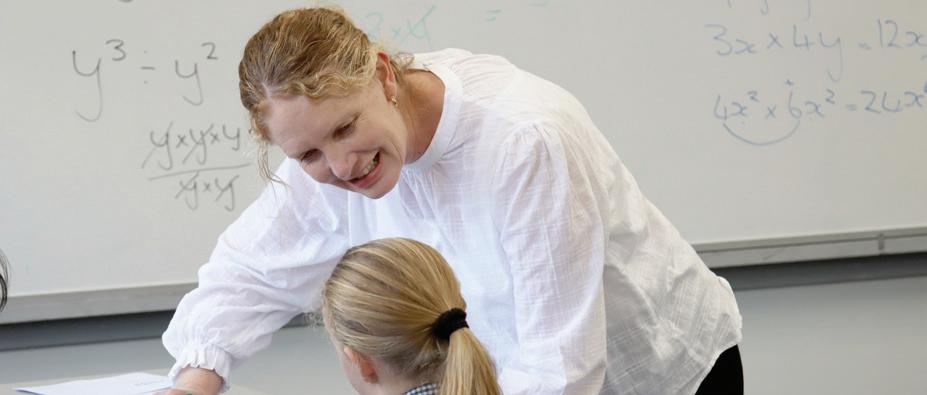

An in-school teacher training programme has seen around 100 new teachers enter the workforce over the past three years.
Driven by four Auckland principals, the Auckland Schools’ Teacher Training Programme (ASTTP) is supporting career changers to take the leap into teaching. It’s run in conjunction with the University of Waikato’s remote teacher education training programme.
The principals involved in developing the initiative were Tim O’Connor, Auckland Grammar School; Steven Hargraves, Macleans College; Justine Mahon, St Cuthbert’s College and David Ferguson, Westlake Boys’ High School.
“We tried a few different things at Westlake – speaking to cohorts at university at the start of their postgraduate diploma year, sponsoring people prior to them becoming teachers. That worked out well, but I just thought it would be worth trying to have them based at schools.
“The University of Waikato had a remote learning programme anyway, so they were very receptive to the idea and were a natural partner,” says David.
This year, 26 Auckland secondary schools are taking part in the programme, hosting 64 trainee teachers with the Ministry covering the cost of fees and a stipend. Around 80 percent of the students are career changers. In the past two years, nearly all have been employed by the school that hosts them.
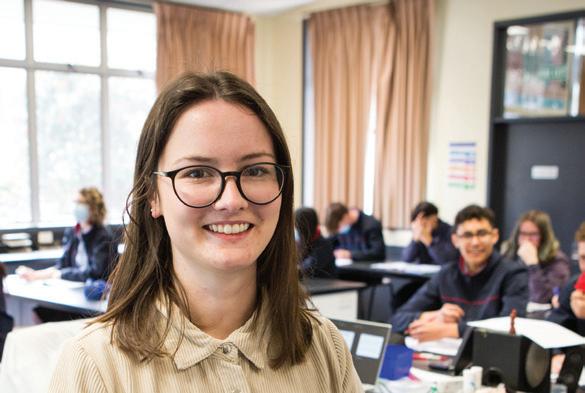
“The vast majority have had a career in something else and they offer unique skills and experiences. We have deliberately targeted career changers. I can’t speak for all schools, but most have recruited through school communities and word of mouth.



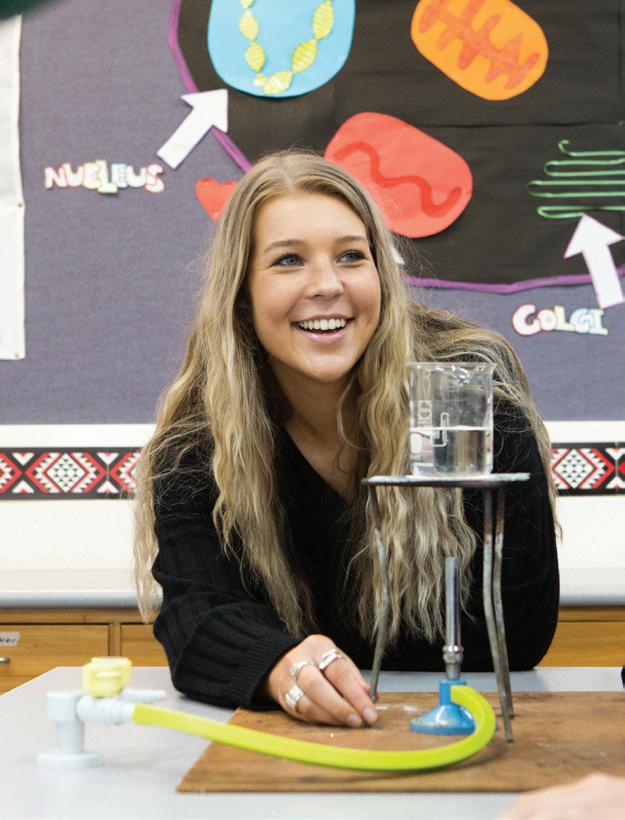
“It’s a significant investment so the schools do the due diligence upfront and see if that person is going to be a good fit. There’s no guarantee that there’s going to be a job, but a lot of schools are taking these people on in shortage areas,” explains David.
Stephen Butterworth (Ngāti Porou) has had a long and successful career in theatre and television in Aotearoa and overseas and describes himself as a post-Covid career changer. While Covid impacted the arts, that’s not why he decided to train to be a teacher.
“During Covid, people began questioning themselves as to what they were doing in their lives and the value they were putting towards the world and the future. The arts industry picked up quite quickly, but within that time, I compiled all my work in a large scrapbook. While there was a huge amount of work, it was like one in every four or five years, that I would think ‘Yes! that’s amazing’.
“When I started having more contact judging Shakespeare in Schools and directing theatre productions for schools, I realised that my passion and excitement was greater for teaching children. Not only was the need there, but I got a lot out of teaching – more than I ever did on stage,” he says.
Stephen has undergraduate degrees in geography, and in drama through Toi Whakaari; he’s been enjoying exploring his roots and matāuranga Māori through the course work.
“The papers from Waikato this year have really made me think deeply as to why my mother didn’t teach us Māori growing up. My mother was chastised for speaking Māori at school, but I didn’t realise that the effects of that would still be prevalent in us. It’s not really for myself to do this, but for my Mum, my culture and my people because it’s really important that we not only get Māori back into teaching, but Māori males as well.
“So now I’m going to make sure that I’m introducing as much Māori into my lessons as possible and I’m loving it,” he says.
Stephen is doing his in-school training at St Cuthbert’s College, and a required practicum (25 days in the year) at Westlake Boys’ High School. He will be looking for a
teaching job in Auckland at the end of the year.
He became a LAT (limited authority to teach) two years ago when working with Year 7 and 8 drama students at Diocesan School for Girls. He taught Year 10 drama at St Cuthbert’s last year and it was then suggested he apply for an ASTTP scholarship.
As well as full-time online study and the ASTTP requirements, which include teaching a junior and senior class in his subject area, Stephen has been teaching relief classes, is acting in a show and has a contract to direct Frozen at another Auckland school.
“It’s overwhelming at times – but I’ve got through it. As a mature student it’s good to be able to turn down acting work and say, ‘You know what? I’m happy to be teaching 30 students in drama right now.’ I’m learning to say ‘no’, it’s so empowering!”
Gill Scott graduated with a business and marketing degree and worked for approximately 20 years in various roles in the business and legal world. She then volunteered at her children’s school before being offered a position as a teacher aide. She became an ESOL teacher and she now teaches maths as a LAT at Glenfield College, where she will have a teaching job next year.
“I have been working at Glenfield College for four years now. The principal, Paul McKinley, and the previous SENCO kept saying ‘You’re a natural teacher – you need to train!’
“To be a teacher you have to have a passion for it. My youngest is 15 and I could have gone back into the corporate world, but this is what I love. My boss has been encouraging me to do it for a long time.”
While Gill is “loving the learning”, she is also working full-time and fits in the required study in the evening. She is fortunate that she can do her practicum at nearby Westlake Boys’ High School when she has one or two non-contact periods at Glenfield College.
“I go to Westlake Boys’ as my practicum school – just seeing all the different teachers and teaching styles is really good. When my seniors leave for NCEA exams, I’ll have more time for the practicum.
“I do the study until midnight or two in the morning and then I get up and go to work next day. It’s exhausting and not something that I would recommend, but I keep telling myself that it’s only a year!” she laughs.
“As a mature student it’s good to be able to turn down acting work and say, ‘You know what? I’m happy to be teaching 30 students in drama right now’.”
Stephen Butterworth
Gill says that through the course work, she has learned different ways to make mathematics more exciting. She particularly likes working with ākonga who struggle.
“It’s gratifying just to see some progress that they’re making – to see them happy.”
A strength of the training programme (ASTTP) is that not only are trainee teachers encouraged to do a practicum at a school that is different from their base school, but the whole cohort attends professional learning and development (PLD) workshops at 12 different schools during the year. The trainees also have time to network, socialise and support each other.
“Each school we go to, we’re learning something different – one school might focus on professional growth, and another on cultural responsiveness. There will be a kind of lecture for the first hour or two and then we get to go into the classrooms of those schools, just to see how different teachers teach and manage classrooms in different ways,” explains Gill.
She has enjoyed meeting the wide range of people who are in the programme.
“I’ve met so many people and they’re from so many different walks of life. There are quite a few young ones straight out of university, but there’s a lawyer – he decided he’s earned enough money and wants to follow his passion. There’s also a firefighter who’s going to be a teacher and a university professor who has decided he wants to teach secondary school. The 64 of us regularly meet and go to other schools, so we get to see how other schools work,” says Gill.
David says that most trainees have said they wouldn’t want to go back to university full-time.
“They prefer this as a way of preparing for teaching. This programme persuaded them to take the leap and sign up for it,” he says.
Feedback from schools involved in the programme is that the ASTTP teachers are well placed at the start of their teaching careers.
“The schools feel they’re more advanced than beginning, first-year teachers normally are. Secondly, they are used to the culture of the school. They’ve done a lot of things that first-year teachers wouldn’t normally do like have a form class, coach teams, and they are used to the systems and processes in the school, making the transition into the first year easier.”
The programme is already attracting widespread interest.
“Approximately 12 new schools have got in touch that want to sign up next year – just in Auckland. We’ve been contacted by other regions to ask about it as well. There’s a lot of interest and I would imagine it will continue to be part of the initial teacher education landscape for a number of years.
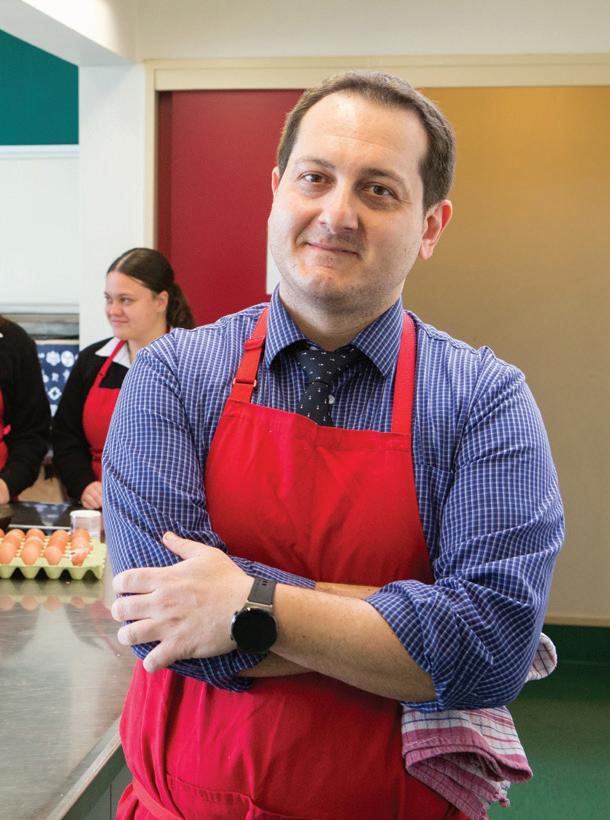
“It’s an appealing way of training. I don’t think it’s going to fix the teacher shortage, but it certainly helps,” concludes David.

For more information about the Auckland Schools’ Teacher Training Programme (ASTTP), visit schoolbasedtraining.org.
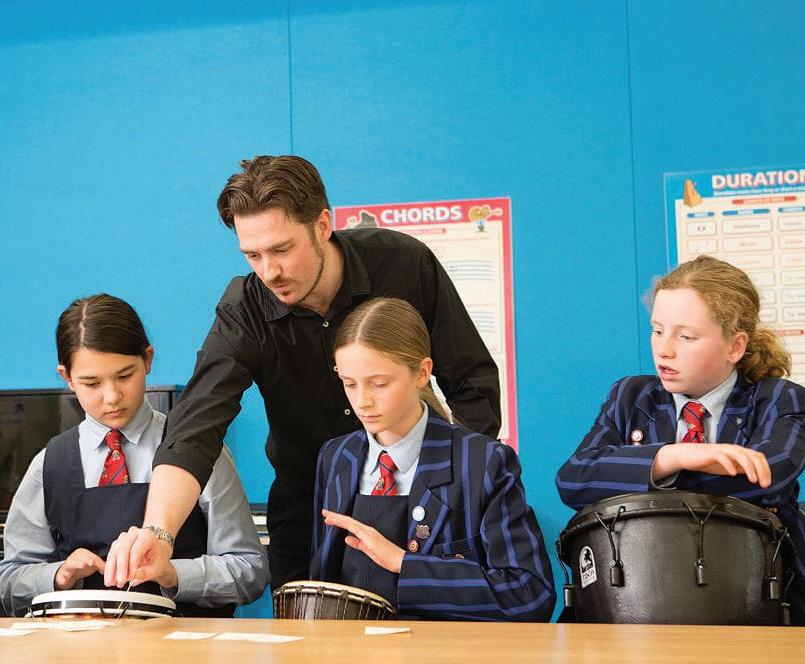
A free resource for teachers, designed for inquiry learning with Years 7 and 8 ākonga.
Visual inquiry cards to explore the connections between the communities and cultures of Aotearoa New Zealand and Asia.
Learning linked to Te ao Tangata | Social Sciences
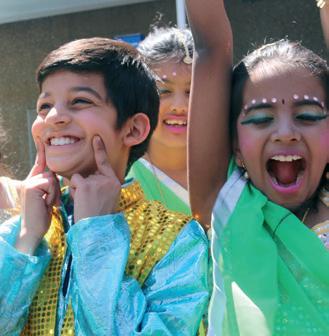

Understand, Know, Do framework.

www.asianz.org.nz
Teacher guide included - scan the QR code!

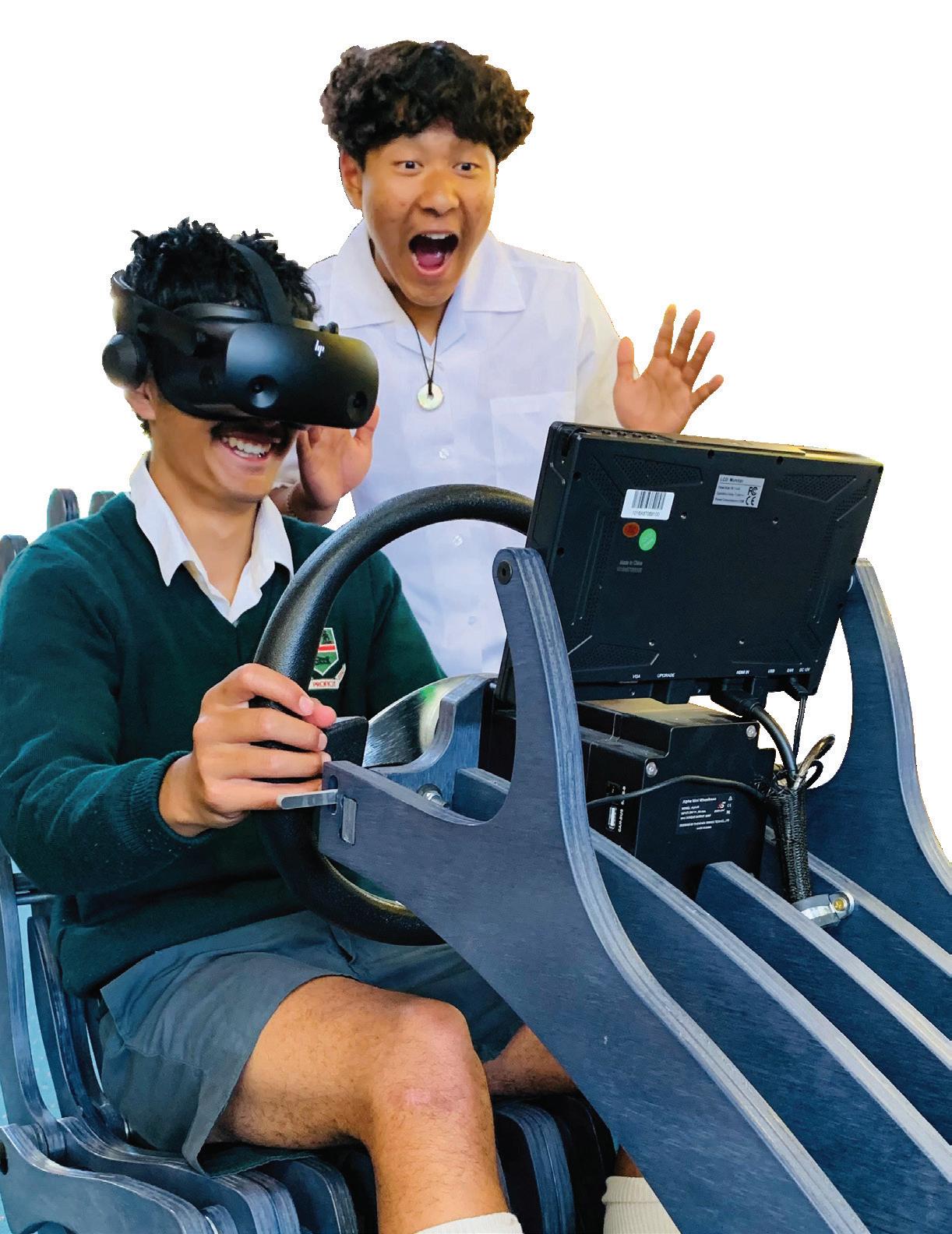
Waimate High School’s rural South Canterbury location means learning to drive can be more difficult for students. But virtual reality technology CoDriVR is helping students gain vital driving experience without even leaving the school grounds. The project is an example of how EdTech can help transform teaching and learning.
Virtual reality technology is helping to bridge barriers and create safer young drivers by enabling students at Waimate HIgh School to gain practical driving experience without having to leave the school grounds.
A small school of about 270 students from Years 7 to 13, Waimate’s rural location makes travelling to sports, arts or other extracurricular events more challenging.
Ngakau, a student at the school, knows just how difficult this can be.
“In my family there’s five kids that love playing rugby so trying to make travel work is a real issue for my parents,” he says.
It also means that gaining driving experience, especially on busy roads, requires travel.
“In Waimate you don’t have a driving school or anything like that,” says Georgia, another student at the school.
“If you want to, you have to pay for them to come down. I think it [driving experience] is super important for us – especially in a small town where there’s not that much traffic.”
The school now has virtual reality driving simulator CoDriVR installed in its library, enabling students to gain valuable driving time which will help when it’s time to get their licence.
Rhys Gardner, CEO of EdTech startup CoDriVR, says the technology breaks down barriers.
“The biggest barrier to learning to drive is that the only way to learn to drive is to drive. You’ve actually got to get behind the wheel of a vehicle of some sort, so virtual reality and simulation is one of the most realistic tools,” he says.
VR is transformational CoDriVR is a virtual reality driving simulation programme. It gives users experience driving on New Zealand roads without actually being in a car.
It is one of many EdTech NZ startups offering innovative technology which is transforming teaching and learning.
Kellie Tagiaia, deputy principal of Waimate High School, says being able to access CoDriVR at the school has been “really positive” for students.
“Technology in schools is like technology around the world, it’s forever changing, it’s never constant,” she says.
“They’ve been able to use it to learn practical skills that they can take into the real world to help them develop and grow their skills around driving. And to work towards their driver’s licensing.”
Claire Paterson, director of CoDriVR, says the driving simulator helps students apply what they’ve learned in the New Zealand Road Code, before they’re allowed on the road.
“We’ve had feedback from users of the simulator where they’ve been learning the road code and then they come in on the simulator and what they’ve learned actually makes sense.”
Georgia says using the virtual reality technology means she is able to see what driving in traffic would be like without having to drive to Timaru or Oamuru to get the same experience.
“I feel like CoDriVR helped me a lot because I was quite nervous when I went to start driving, so it calmed me down and made it a lot easier for me.”
Ngakau, who is working towards gaining his restricted licence, says he has been able to put what he’s learned through CoDriVR into action on the roads.
“CoDriVR emphasises checking your mirrors and blind spots which really helped when I was driving around town with Mum because she noticed I was checking my mirrors a lot and making sure I was all clear to pull out safely.”
The power of EdTech
CoDriVR is an example of the wider impact EdTech can have in society. Rhys says the simulator is a logical place to solve issues around both road safety and access.
Transformed learning, teaching, assessment, and
Data from the Ministry of Transport shows in 2021 there were 74 fatal crashes, 538 serious injury crashes, and 2,892 minor injury crashes involving young drivers aged 15 to 24.
“We’ve got a social cost of youth road accidents in the billions. Anything we can do to reduce that has significant outcomes for the community and wider populations,” says Rhys.
Meanwhile, a 2016 report sponsored by ACC and the New Zealand Transport Agency showed that aside from the safety issues around young drivers, those aged 18 to 24 who didn’t have a licence were more likely to be unemployed and end up in the court system.

The report showed 70 percent of jobs required a licence and just nine percent of young people aged 18 to 24 who received a benefit held a full licence.
“Only five percent of students are leaving school with a full licence,” says Claire. “It [CoDriVR] gives a lot of young people the opportunity to practise and creates motivation to get out there and get on the road – safely.”
Georgia says not everyone has the same access to technology so having CoDriVR at school meant it was convenient to use.
“I definitely think CoDriVR would be really helpful for all students in New Zealand; teenagers who are learning to drive especially and who are on their learners.”
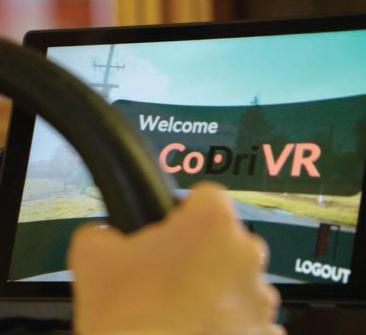
“This is an important equity issue too,” says Claire, “It’s unrealistic to think all families will be able to even afford driving lessons for their kids. On the back of an envelope, if you estimate 40 hours of lessons at say $80 an hour – that’s $3,200.
“So, what happens to those who don’t have access to that kind of money or a vehicle? Offering VR training is a social leveller – great safety training for all our young people learning to drive which is an important life skill, no matter what their family situation may be.”
Kellie says not only is virtual reality technology helping students gain driving experience, it is also opening their eyes to the power of technology.
“It’s starting to show them in the real world what technology can look like, what it can be used for; and actually, if they’re interested in that pathway, they can see how what they do here at school – whether it’s coding, gaming, programming – how they can contribute to any sort of technology space as a real-world future ambition.”
Rhys says the future is pretty exciting for youth.
“Especially through the use of virtual reality technology and where you can live in someone else’s shoes, it’s really going to shift the perspective of your own life and the ability to both relate to others and connect with people around the world.”
Learning, teaching, assessment, and research can be transformed by digital and data to lift wellbeing, maximise capability and improve learning outcomes, and at all levels, it can be enhanced by appropriate best use of digital and data approaches.
Education agencies are working to ensure education includes the skills learners need to thrive in the digital world. This includes our approaches to safety and wellbeing, curriculum, assessment and research and building the capability of educators. There is a rich and evolving digital strand to all these areas of work.
The inclusion of driver education in local curricula is at the discretion of individual schools based on the priorities of their school communities as it is not part of the national curriculum.

The Ministry of Education is involved in the cross-agency Driver Licence Improvement Programme (DLIP) led by Waka Kotahi and the Ministry of Social Development and is supporting partner agencies to reach school students who need driver licence support.
Life skills are an important component of the education system envisaged in the National Education and Learning Priorities. These skills sit within compulsory learning areas of The New Zealand Curriculum, such as social science, although schools do currently have flexibility as to how life skills such as civics, wellbeing | hauora and financial literacy are delivered through their local curriculum.

The Ministry tools to support the teaching and learning of life skills for school leavers include:
» A student-focused School Leavers’ Toolkit: school-leavers-toolkit.education.govt.nz.
» A teacher-focused School Leavers’ Toolkit: sltk-resources.tki.org.nz.
“Offering VR training is a social leveller – great safety training for all our young people learning to drive, which is an important life skill, no matter what their family situation may be.”
Kellie TagiaiaKellie Tagiaia, deputy principal of Waimate High School.
CoDriVR is an example of EdTech transforming teaching and learning and opening the door to new career opportunities. Alison Mackie, executive director of EdTech NZ explains more about the growing sector in Aotearoa.
In 2020 $173.6 million was spent on education software – this is projected to reach $319.6 million by 2025. Of the current EdTechs in New Zealand, 65 percent were established in the last 10 years and about six percent earn $20 million in revenue each year.
There are many benefits of EdTech. It allows for: personalised instruction directed at individual learners; the ability to cater to students where a traditional model doesn’t fit; and – as highlighted in the case of Waimate High School and CoDriVR – the possibility to deal with situations like those where face-to-face learning is not available, or where there are equity and access issues.
The current EdTech ecosystem in Aotearoa thrives on innovation and is home to a multitude of world-class products and services. Over 60 businesses join forces under the industry organisation, EdTech NZ, to help foster a vibrant community dedicated to pioneering education technology.
Cutting-edge technologies such as generative artificial intelligence and virtual reality are at the forefront of this innovation, making digital literacy an essential facet of active 21st-century citizenship.
Companies like Kai's Education and VR Voom are transforming education, combining coding, augmented reality, and virtual reality to create immersive and engaging learning environments. Kai's Education has developed AR VR adventure mats with 3D virtual layers, allowing students to code and immerse themselves in 3D worlds, whereas VR Voom focuses on providing virtual reality experiences that span entertainment, adventure, and education.
Geo A.R. Games and ARA Journeys are also prominent figures, with the former pioneering Geospatial Augmented Reality to merge outdoor activities with mobile gaming, and the latter employing AR, VR, mixed realities, and AI to breathe life into history through gamified storytelling platforms.

The gaming industry, already contributing over $400 million to the economy in 2022, is poised for further growth and also serves as a catalyst for our EdTech sector.
The synergy between gaming and education sectors paves the way for enhanced learning experiences, increased student engagement, and improved retention rates. We anticipate a surge of talent and skills that could be channelled toward the EdTech sector, leading to wider adoption of gamified learning experiences. This, in turn, is set to ignite the curiosity of our young learners, fostering their engagement, and uplifting their educational journeys.
“The biggest barrier to learning to drive is that the only way to learn to drive is to drive. You’ve actually got to get behind the wheel of a vehicle of some sort, so virtual reality and simulation is one of the most realistic tools.”
Rhys GardnerDriving in the virtual reality simulator gives students a very life-like experience of being on the road.
Education Gazette is offering a series of articles highlighting digital success stories from across the education sector.
Stories like this one of new approaches to digital in education are being regularly showcased. This series will introduce you to students and educators from early childhood, compulsory schooling, alternative education, and tertiary.
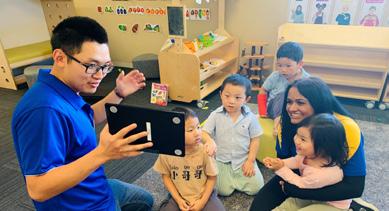
You will meet Amethyst (who’s developing a student-led Maker Space for the
community through
Te Ara Poutama Alternative Education Centre), and Romana from Digimatua (who is building digital skills for Pacific families to be able to better support their children’s education), and many others.
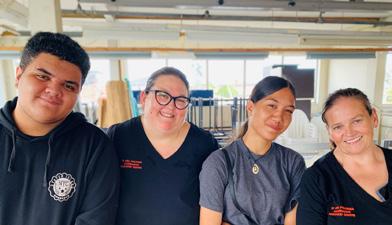
All videos are available online at education.govt.nz/digitalstrategy. All articles will be available online at gazette.education.nz.
How are families with stronger digital skills better supporting children’s education with Digimatua’s Pacific community digital inclusion programme?



How can te ao Māori impact a digital world to create a special place for deaf learners at Rūaumoko Marae?
How is building teachers’ digital skills sparking imagination in learners at Avonside Girls’ High School?

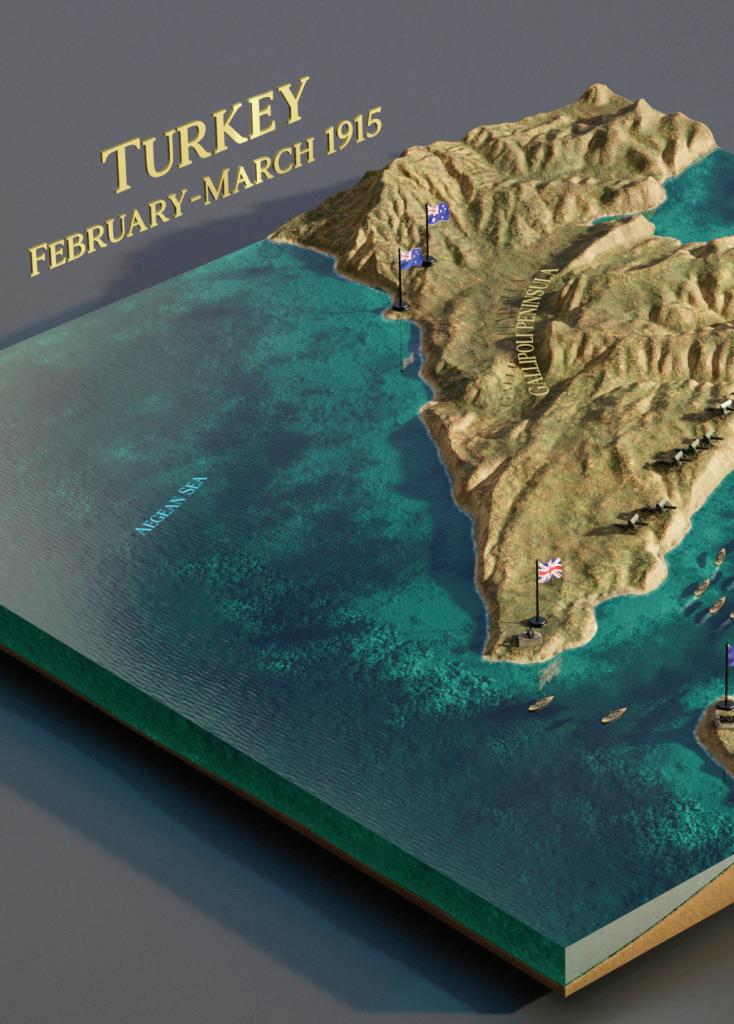
Resources like stories, podcasts, photographs, art, film and other taonga of our cultural heritage are used to teach students about the history of Aotearoa New Zealand. But virtual and augmented reality resources bring past events to life by immersing students in interactive learning.
Technology teacher Pamela Morrow (Ngāti Pū) says through her own research, she knows there is a significant gap in using and understanding the tools that are out there.
“I think there is some urgency to make sure students are up to date with present technologies to prepare them for the future.”
A free interactive augmented reality app telling the story of Gallipoli is currently being tested. The app is called Anzacs at Gallipoli and a final version of the app will be released later this year. It will include both te reo Māori and English language options and it will be available for free download from both Google play and the Apple app store.

One of the app’s development partners, Patrick Brontë, says the app is suitable for Years 7 to 11. He has been collaborating with Waxeye, a creative technology studio, to create the experience.
Patrick initiated the Anzacs at Gallipoli project by raising money through the Ngā Toa Charitable Trust and contributing his own money.
“I was determined the app would be free for schools,” he says.
“Enormous effort has gone into the content of Anzacs at Gallipoli to ensure every element is accurate.”
Patrick Brontë
With the ability to follow ships, uncover hidden tunnels and watch battling soldiers from up close, students can truly transport themselves to a different time and place.

 Interactive hotspots allow students to access more detailed information in their own time, uncovering 360-degree models of weapons, audio tracks and historic photos for a more enriching learning experience.
Interactive hotspots allow students to access more detailed information in their own time, uncovering 360-degree models of weapons, audio tracks and historic photos for a more enriching learning experience.
“Enormous effort has gone into the content of Anzacs at Gallipoli to ensure every element is accurate,” says Patrick.
The narrative was written by military historian and Gallipoli expert Christopher Pugsley, while 3D artists from Waxeye crafted each element with authenticity, including battlefields, warcraft, soldiers, and weapons.
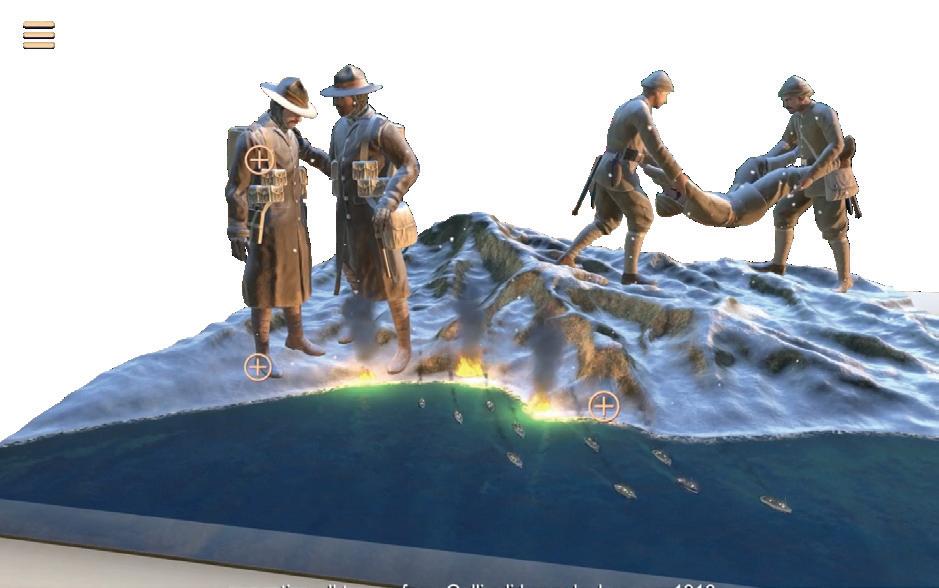
Patrick is no slouch when it comes to military history either. He has created 570 filmed interviews of returned New Zealand servicemen from World War II through to Afghanistan.
A tetraplegic after an accident at 16, Patrick’s support person films the interviews while Patrick conducts and directs them.
His university training in media and his subject expertise has also led to other opportunities like coproducing TVNZ’s War Cry, a documentary dealing with the mental health of ex-servicemen. War Cry is a compilation of Patrick’s interviews.
Pamela says she was in the classroom last year when Waxeye brought the Anzacs at Gallipoli app to Hobsonville School to get feedback from teachers and students.
“Students enjoyed using the app and one student wanted to create something similar. Augmented reality certainly brings a new dimension to learning. Having a story unfold in the same space occupied by the student is a powerful way to learn. It does bring the subject to life,” she says.
Pamela says she could see the tremendous potential of the app for learners.
“We also had an opportunity that day to look at a virtual reality experience created by Waxeye: Karanga a Tāne Mahuta.”
Delivered in te reo Māori with English options, it connects taitamariki with their environment through a reconstruction of unique taonga species, flora, and fauna.
The aim is to help young people better understand the impact of environmental changes.
“There was a lot of excitement. The principal and the deputy principal popped in to have a look at both resources. Afterwards, word got around and students who weren’t in my class were approaching me in the playground excited about the possibility of a virtual reality experience.
“I think there is a great need for these sorts of projects to tell our own historical stories. Schools can prepare our taitamariki for the future by supporting educators to teach the wider implications of technology use. Teaching critical tools and applying them to technology developments is very important.”
“Augmented reality certainly brings a new dimension to learning. Having a story unfold in the same space occupied by the student is a powerful way to learn.”
Pamela MorrowThe immersive app lets students explore what it was like to dig trenches, take cover from enemy fire and feel the adrenaline rush of battle. The Anzacs in Gallipoli app is currently available as a beta release and only works on iPad. The project team is working with a range of schools for user testing before a wider production version is released later in the year.
AR and VR, in this context, enables students to explore aspects of the Aotearoa New Zealand’s histories (ANZH) curriculum.




ANZH is now embedded within te ao tangata | social sciences. Exploring Aotearoa New Zealand’s participation in international conflict as a meaningful topic connects learning with many aspects of the ANZH curriculum. Specifically, it connects to the Understand statement People’s lived experiences have been shaped by the use and misuse of power which is across all phases of learning. This statement captures the idea that individuals, groups, and organisations exert and contest power in ways that improve the lives of people and communities, and in ways that lead to exclusion, injustice, and conflict. The course of Aotearoa New Zealand’s history has been shaped by the exercise and effects of power.
Additionally, this topic unpacks the Know statement Culture and collective identity, particularly in the progress outcome 4 (learning by the end of Year 10), where Aotearoa New Zealand’s participation in international conflicts over time reflects our changing view of our country’s place in the world and our identity. Our remembrance of these conflicts and our honouring of those involved has evolved over time.
Interactive maps are structured in chapter and timeline formats incorporating animation and voiceover to bring the story to life. The skilled team of 3D artists from creative technology studio Waxeye wrecked closely with historians to craft authentic 3D models.Augmented Reality (AR) is a technology that overlays computer-generated content, such as images, videos, or 3D models, onto the real-world environment, like a student’s desk or a table. It enhances and augments the user’s perception and interaction with the surroundings produced by the app. These apps can be used without prior knowledge of the medium.
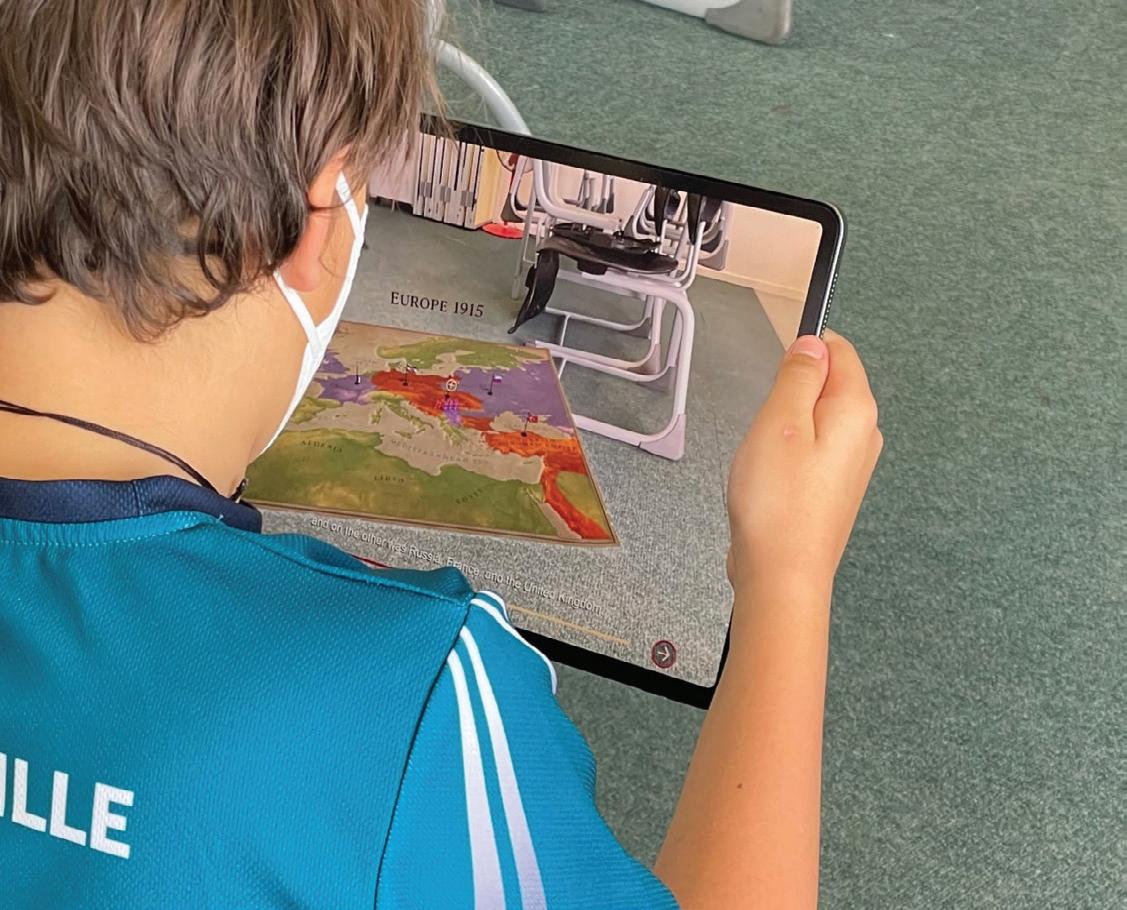
Virtual Reality (VR) is a technology that creates a computer-generated, immersive, and interactive three-dimensional (3D) environment, allowing users to experience and interact with simulated worlds or scenarios. Wearing specialised goggles enables you to access the 3D environment.


All over the country, schools and kura have been coming up with innovative ways to introduce the Aotearoa New Zealand’s histories curriculum into their learning experiences. In the heart of the Waikato region, Morrinsville Intermediate School staff and students have taken the opportunity bring local pūrakau to life on the stage.
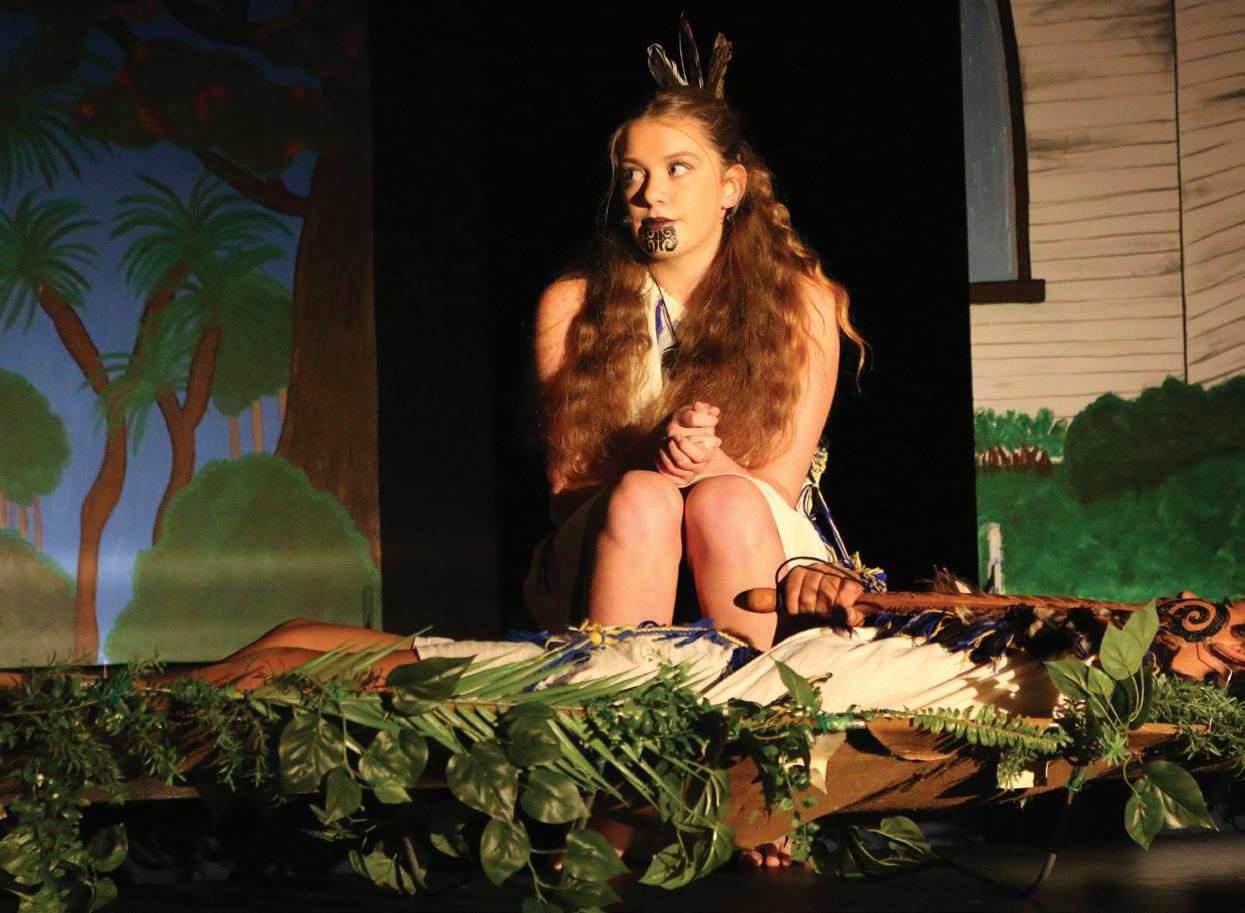
When thinking about how to implement the Aotearoa New Zealand’s histories curriculum at their kura, Morrinsville Intermediate School decided to start their journey close to home.
The result is the school’s latest stage production – The Time Travelling Waka.
The Time Travelling Waka takes the audience on a voyage of discovery through the ages and in the process has given the opportunity for learning, not just for students, but staff and the Waikato town’s wider community.
Led by teacher Bailee Foulds, the school started with a focus on the significant pūrakau of local iwi Ngāti Hauā.
With support and close consultation from Kaumatua Te Ao Marama Maaka (cultural advisor to Ngāti Hauā), Tumuaki Hone Thompson and other Ngāti Hauā kaumatua, Bailee comprehensively researched online, read numerous books and listened to oral stories, to map out a storyline and write a play about the history of their local area.
The production’s timeline begins in the 1500s with siblings Hauā, Hape and Ruru journeying to Te Au o Waikato and then shifts to the battle between Ngāti Hauā, Ngāti Hinerangi and Ngāti Tāwhaki, in which one of Hauā’s sons, Werewere, is killed and Ngāti Hauā is gifted land in the Matamata-Piako area.
It then moves to the 1700s and the birth of Te Waharoa, paramount chief of Ngāti Hauā.
The story continues into the 1800s and the birth of Te Waharoa’s son, Tarapīriri Te Waharoa in 1805, who was baptised in 1839 as Wiremu Tamihana and anoints the first Māori King – Te Arikinui Kīngi Potatau Te Wherowhero.
Empowered
Morrinsville Intermediate principal Jenny Clark says from her perspective she is really proud of the way they’ve been able to bring the Aotearoa New Zealand’s histories curriculum to life by showcasing local pūrakau on the stage.

This has created an authentic opportunity for their ākonga and the wider community to connect with the Understand, Know, Do framework, which is the process underpinning the curriculum refresh, she says.
“For those students in the production, they will now have a lifelong understanding due to the innovative way in which they have been involved in The Time Travelling Waka,” she says.
“As principal I am very proud of the way Bailee Foulds, along with other staff, were empowered to succeed through their courage and internal commitment to ‘make it happen’.”
Students understanding and knowing local stories has been part of the school’s strategic plan for the past two years, she says.
“But we feel adding the ‘Do’ element this year has certainly been a game changer.”
“For those students in the production, they will now have a lifelong understanding due to the innovative way in which they have been involved in The Time Travelling Waka”
Jenny ClarkSam, Kees, Petelo and Campbell perform the haka Tau Ka Tau.
Bailee says their process started with building a base storyline and presenting a scene breakdown to a group of Ngāti Hauā representatives.
This involved reading different novels and articles, a huge amount of online research, as well as listening to some of the local pūrakau through oral storytelling.
“It was exciting to be able to work alongside Ngāti Hauā to develop such a rich learning experience for our kura and wider community,” she says.
As part of the planning process Bailee was also joined by the school’s Mahi Tahi Roopu.
“These Year 8 students were involved in organising many key elements of the production from writing rap lyrics and sections of dialogue to planning the initial concepts for our set and props,” she says.
“It was an honour seeing our tamariki rise to the occasion. We had many ākonga who were pushed well out of their comfort zones.
“For the size of our kura (320 students) I was very impressed that we were able to include almost 130 eager students to perform various roles!”
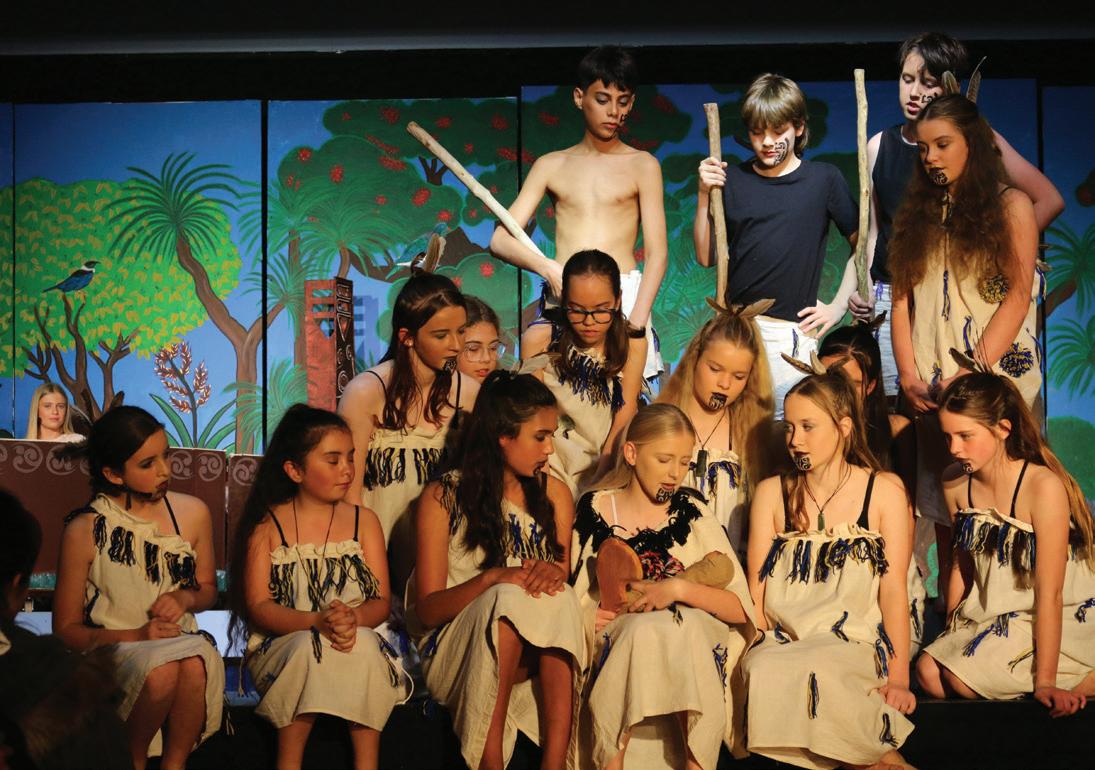
During the production, every time the waka moved through the past, this was accompanied with waiata, haka, or dance.
“I believe this was a really effective way to transition between different time periods and set changes while engaging our audience and showcasing the talent in our kura.”



Bailee says she feels privileged to have been able to retell this history with the unwavering support from the kura, community and Ngāti Hauā.
“We performed to five local schools, including our own, and performed two evening shows to sell-out audiences of 250 people each night.”
To ensure the rest of the school also got to ‘understand’ the pūrakau of the local area, they made up the audience for the first technical run through.
Other local schools were also invited to the production, including Ngāti Hauā School.


Jenny says through their innovation they’re aiming to have a sustainable impact by enabling the stories to be re-told and shared in the future.
She says the school is appreciative of a generous Creatives in Schools grant from the Ministry of Education that has helped to bring The Time Travelling Waka to the stage.
This came with the assistance of Toni Garson, who was able to bring invaluable theatre experience to the production, contributing to its success.
The production has been commercially filmed to ensure the school has a sustainable resource for future teaching and learning purposes.
“This has been a very ambitious project, but one which aligns beautifully with our school vision, ‘Empowering Learners to Succeed’, and empowering both students and staff,” she says.

Many members of Ngāti Hauā attended the final show and were very complimentary of how it all came together.
“At the end of the matinée show, we had whānau in the audience spontaneously haka our cast. So very humbling but awesome for our tamariki.”
Collaborative art projects deliver much more than beautiful wall decorations. They serve as opportunities for ākonga to express their individuality and build relationships based on trust and respect.

In Grant Arendse’s Year 4 classroom, the year begins with a collaborative art project.
Ākonga buddy up to create art that will be pulled together into one giant wall decoration. As they toil away with collage and paint, the children are also creating friendships and positive work habits.
“The aspect of relating to each other is just as important
as the creativity and the final product,” says Grant.
“It’s a low-stakes way for ākonga to get to know each other and get used to their new classroom. The start of a year is a good time because that’s when the student group is new and classroom expectations are being established; we’re building a positive culture with ākonga respecting each other.

“You’re talking, you’re making connections, and being creative is about expressing yourself which is great for self-esteem.”
Grant teaches at Milford Primary School in Tāmaki Makaurau Auckland. It’s an International Baccalaureate (IB) school.
“We are big on inquiry-based learning and on transdisciplinary nature of learning. Everything is integrated.”
Although he is a fine arts graduate, Grant says kaiako do not need to be artistic to lead successful collective art projects.
“Usually, collaborative art is linked to a big unit of inquiry that the class is working on. At the end, the students are proud to see their art on the wall and you point out that this was achieved through teamwork, that if they’d done it alone, it wouldn’t have had the same impact.”

In their latest project, Grant’s class worked in groups to create a star galaxy background by layering different colours onto black card.

“We worked step-by-step, starting with a video on layering paint to create the impression of galaxies and star clusters,” explains Grant. Students then chose a gold or silver star and a value to go on that star.
“This was linked with our unit about who we are, and how our actions, values and mindset shape our identity. Things like, ‘be kind to others’, ‘always do your best’.”
Ākonga decorated their stars and created something to represent themselves in space – an alien or an astronaut, for example.
When it was finished, Grant photographed the students with their backs to the camera and pointing up at their artwork. “It’s quite striking because the uniform is yellow and the background is a purplish black colour.”
Students chose a toki to go in the centre of the art, electing kindness as the most important value.
“We finished the work by sitting in a circle, looking at the art and sharing what we saw and felt, and what their favourite part had been. One said, ‘We are pointing at the stars because those values are important.’
“They said, ‘We couldn’t have done this by ourselves so it’s important we work together.’ They talked about their characters having similarities and differences and
“They are talking about concepts of identity and difference and diversity and values, and they are only eight years old.”
Grant ArendseAbove: Ākonga felt very proud to make such a stunning artwork. Left: The result is glorious wall art while the process unites ākonga and supports their relationship-building skills.

I feel proud, and I also feel like everyone belongs in the class even though we’re all different.
We’ve got different personalities and we look different. No one’s the same. Our picture shows that because no one’s got the same picture.
I felt really good about it because it gave us a chance to meet all the other people in the classroom and work with them.
When it first went up, we took a big photo in front of it, and everyone was happy. And since then, we’ve been doing a lot of things sometimes working together, sometimes working apart.
how it was OK for everyone to be different. The children are talking about concepts of identity and difference and diversity and values, and they are only eight years old.
“Concepts of identity and diversity need to be unpacked in ways that ākonga can understand and access. Linking it with art makes it more real for them.”
In the words of eight-year-old Sophia: “Doing the art helped us work together. We buddied up, not with our best friends but someone we didn’t know. I was excited because I like meeting new people. I’ve made new friends now.
“I liked the theme too; we are all different but we’re swimming in the same direction. It means that we are all different inside and outside, but we all have the same goal of learning.”
Visual art is a valuable learning area, says Grant, adding that when it’s linked to other areas, it can help to embed the learning.
For example, he says if you are learning about symmetry in maths, you can create an artwork that has symmetry to reinforce that knowledge.
“You could then look at artists who use symmetry in their work. Researching an artist would bring in reading and writing, say by doing an information report. Art is not a standalone thing.
“There will always be students who aren’t strong in maths, who might be more visual, and seeing maths in the context of art can help to cement knowledge. Then there are students who are not strong in reading or writing but they have other strengths. And when it comes to expressing ourselves, everyone can win.”
Grant also points to how kaiako can incorporate literacy by having ākonga write reflections on what they have done, or by leading an artwork project around what the class is reading. He gives the example of James and the Giant Peach.
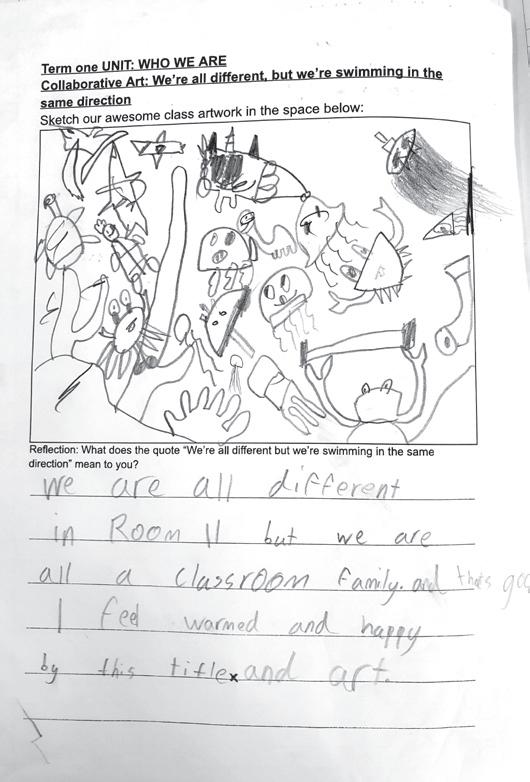
Reflecting on the project provides opportunity for all sorts of learning, such as this writing exercise.
“One teacher did her artwork on Pupukemoana Lake Pupuke and all the things that will be found there. If there are lots of native birds where you are, do one on birds. Use what you have access to and talk with your students to find out is important to them.”
“Doing the art helped us work together. We buddied up, not with our best friends but someone we didn’t know. I’ve made new friends now.”
Sophia, 8


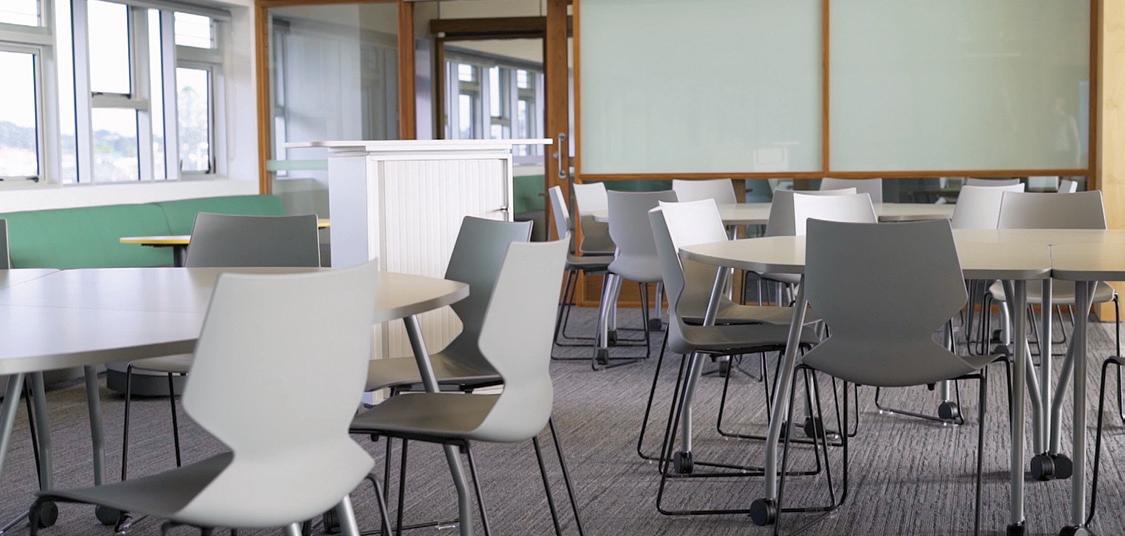

Collaborative art is any kind of art created by people working together to create it and how the collaboration looks can vary.
It might be that each student does their own thing and all works are assembled to make one big artwork. Alternatively, ākonga could work in groups on different elements of the artwork with all those elements being brought together when complete.

Grant says a simple Google search yields many ideas for teachers, and that he also gains inspiration from the Primary Art Ideas Group on Facebook.

Arts Online is the key communication network and quality resource portal for New Zealand arts education. Visit artsonline.tki.org.nz.
Early learning kaiako might like to read NZCER paper Intentionally supporting and extending young children’s learning about and through the visual arts: Suggestions and strategies for early childhood education teachers.
Within NCEA, visual arts students explore, refine, and communicate their own artistic ideas by responding to how art expresses identity, culture, ethnicity, ideas, feelings, moods, beliefs, political viewpoints, and personal perspectives. For more information, visit ncea.education.govt.nz/arts/visual-arts.
This city theme inspired students to consider all the different sorts of homes people have and buildings we use.12pm, 14 September 2023
Sign up to take part




More than 20,000 students have interacted with Rocket Lab’s education programme, which includes school visits, rocket factory tours, rocket clubs and STEM outreach events. The aim is to inspire and educate the next generation about space.
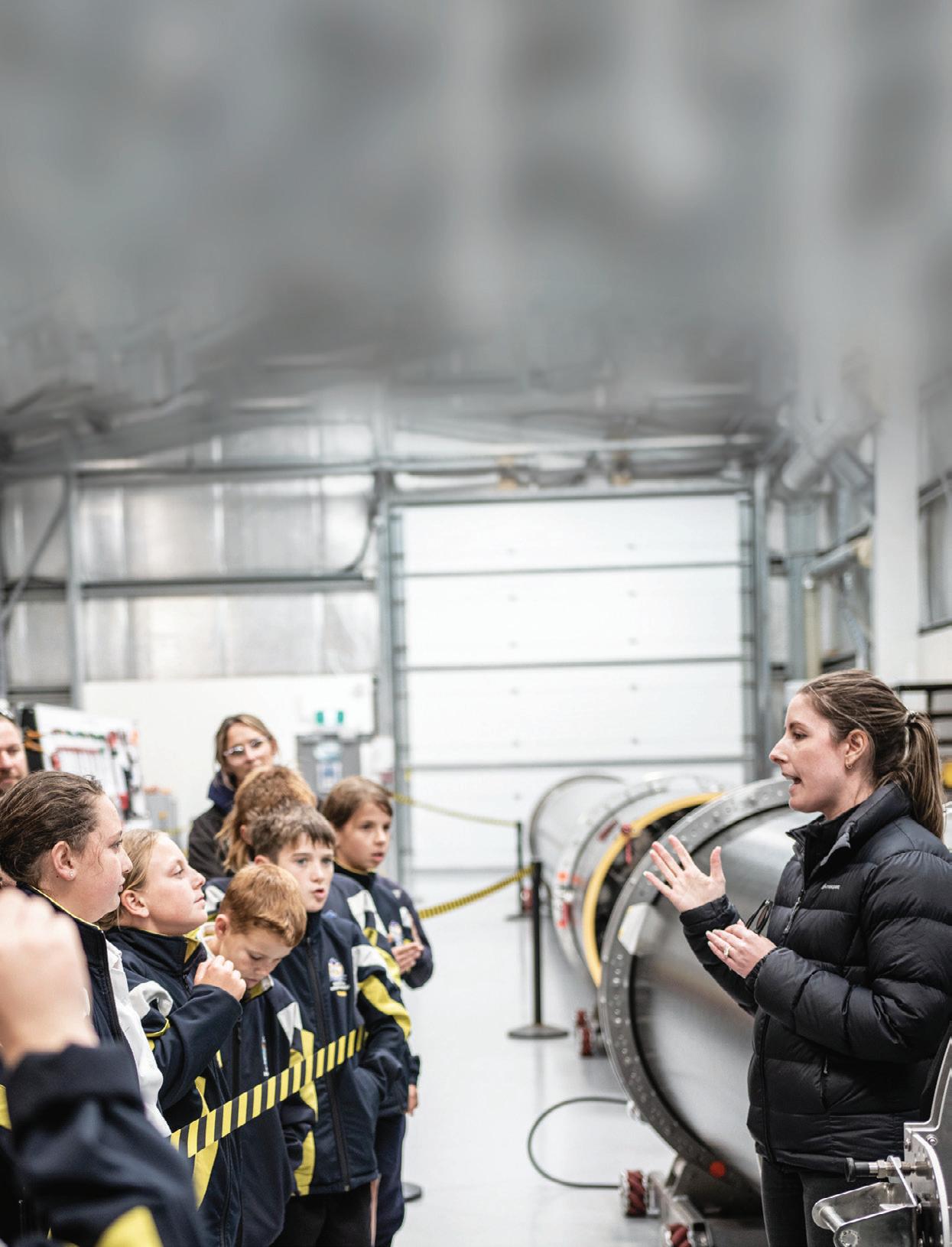
Can I become an astronaut? This is the question that Rocket Lab’s school space ambassadors get asked with every school visit, in-person or online.
“There’s never been a New Zealand astronaut yet, but if you go hard on the STEM subjects, you could be the first,” previous ambassador Rose Swears liked to answer.
“I think it’s important for students to know you don’t have to go to MIT or whatever, you don’t have to move to the US to be a rocket scientist; you can study at the University of Waikato and stay right here in New Zealand and do really amazing, world-class stuff,” she adds.
Earlier this year, Rocket Lab reached a significant milestone with more than 20,000 students interacting with the company’s education programme.
Aspects of the education programme include school visits, rocket factory tours, rocket clubs and STEM outreach events.
The education programme is an essential arm of Rocket Lab as they aim to inspire and educate the next generation about space. Almost 300 schools and community organisations have participated in a Space Ambassador event.
Gisborne Intermediate is one such school, where teacher Barry Huhu signed up to be a Space Ambassador himself, about two years ago.
Since then, the school has had numerous Rocket Lab technicians come and talk, they’ve shared Milo and venison rolls with scientists from NASA and in April this year, 75 students got to visit the Mahia spaceport; Launch Complex 1 at Onenui Station.

“To have an exceptional, international space facility in our region is amazing; to be given the opportunity to explore and learn about what they do – priceless,” Barry says.
“Because LC-1 is a busy operational site, school visits are rare, so these students are among a small group of folks worldwide to get up close to the launch pads. The students learned all about the Electron (rocket) and satellite integration, learned about specialised weather balloons and their role in the launch, and got up close to the launch mount.”
Student Aubrey enjoyed her Rocket Lab visit and says it’s because of the chance to learn more about space and share this knowledge with her family.
Barry links learning about Rocket Lab to the curriculum in creative and innovative ways.
For example, when there’s an upcoming rocket launch, his class has designed mission badges, learning about art and design principles. He’s taught CAD drawing elements, through his students making rockets and launch pads in Minecraft. There have been links to Matariki and discussions on how the space industry can help our environment here on Earth. And of course, the classic bottle rocket has been incorporated into science lessons.
Further learning about space is encouraged through the school’s space cadet programme. In order to join the programme, students must apply, practising their formal writing.



“I’ve always liked space and learning about SpaceX and NASA and how Elon Musk wants to go to Mars. It was really interesting to see that New Zealand has our own company and our own interest in space as well.”
Manu, studentStudents examining the launch mount and strongback at LC-1. This is the structure that raises the Electron rocket from a horizontal position to vertical in preparation for launch. It’s from this exact spot that Electron lifts-off.
Vinzent is one such cadet.
“I’ve been fascinated with rocket exploration for three years now. I’ve always dreamt of being an engineer for Rocket Lab when I’m older and I feel that this opportunity is what will get me into spacecraft and exploration,” he says.
Barry says the technicians speak really well to ākonga, sharing a positive mindset.
“One technician came to our school and talked about how when he mows the lawns, it’s going to be the best lawns he could ever mow. And when he makes tea, it will be the best cup of tea,” he says.
In this way, students are learning not just about STEM topics, but they learn the importance of values such as motivation, passion and self-belief.
“The Rocket Lab staff are great. They’re always saying to our students, send in your CVs, we’ll see you in 15 years,” says Barry.
In an Ambassador’s shoes
While Rose worked as a propellant chemist at Rocket Lab in 2021 and 2022, she also volunteered as a Space Ambassador.
She did virtual visits with schools around the country, and in-person visits at her home town and at Maramarua, near one of Rocket Lab’s test facilities.
“Primary school students are the greatest, they’re not embarrassed to ask silly-sounding questions. There are no silly questions because space science is still so new and so weird that questions that sound a little silly, often have serious answers,” says Rose.
“High schoolers are the greatest too, because they’re starting to understand this is a real thing that they can really do, and they can be crazy insightful with their discussions.”
During her school visits, Rose would talk about her role and then save as much time as possible for a Q&A session.
“Often the class would have been preparing for the visit for weeks, and have awesome questions they just had to get answered.”
Around half of all students engaged in Rocket Lab’s STEM education activities were girls or identified as female.


Rose explained when she was younger, she didn’t have many examples of the kinds of work women could do in STEM fields.
“I had no idea ‘propellant scientist’ was even a thing that existed,” she says.
“[As an ambassador], I wanted to be that kind of example or encouragement to the awesome young people who hopefully, I’ll have the privilege of working with in 10 or 20 years’ time.
“They’re helping encourage our students to dream big, showing that yes, girls can do that job too,” she says.
“Afterwards, our girls are saying, ‘I want to go to space, I want to be just like her’.”

Earlier this year, FIBRE FALE and The Ōtara Youth Drop-in Hub visited Rocket Lab’s factory in Auckland. The goal was to encourage more young Pacific and Māori students into the space industry.
About 30 young people from the hub got to meet with some of Rocket Labs’ own Pacific and Māori engineers, hearing about their personal journeys into the space universe.
Youth Hub senior youth worker Gina Mahani says, “It was awesome to see the WOW on rangatahi faces when they met the Māori and Pacific panelists.
“Even though some of our rangatahi don’t know a lot about engineering, it’s all about exposing them to new opportunities. So many of our shy rangatahi put up their hands for the Q&A, it was so cool to see.”
The dialogue didn’t just focus on engineering but also on opportunities in design, marketing and communications within the space industry.
Student Manu was part of the tour and he says he had never heard of Rocket Lab before the opportunity to go and view their mahi in person.
“It was so cool to see how a start-up had grown and accomplished so much in so little time,” he says.
“I’ve always liked space and learning about SpaceX and NASA and how Elon Musk wants to go to Mars. It was really interesting to see that New Zealand has our own company and our own interest in space as well … We’re basically a part of the space race too.”

Gisborne Intermediate has also had a visit from a current Rocket Lab technician who happened to be an ex-student.

“It’s important that our tamariki are able to meet people who were Gisborne Intermediate students, who are Māori and who also dream big, just like them,” Barry says.
Although the Space Ambassador programme has been paused for the remainder of the year, Rocket Lab is encouraging teachers to get involved in 2024.
“[During my Ambassador role], I got to meet learners from all age groups, and the teachers were sometimes even more excited than their class,” Rose says.
The company is currently expanding its education programme internationally to meet the demands, also encouraging space ambassador applicants from American schools.
Barry says the Space Ambassador programme is a great way for “space geek” teachers to engage with Rocket Lab and provide a gateway to new opportunities for their students.
“Rocket Lab is approachable and they are eager to get into schools. Once we’re underway again I would really recommend schools get involved. Even if it’s just a Skype call, the students get really excited,” he says.
Barry is already excited for that green light. He hopes to be a Space Ambassador for as long as he can. He already jokes with his current students, saying, “Remember, when you are working at Rocket Lab one day, I’ll still be bringing my new students around to visit.”
The Ministry of Education is under way with refreshing the science and technology learning areas of the curriculum and this will be available to schools in 2024.
As part of the kaupapa of Te Mātaiaho | the refreshed NZ curriculum, the content will be written with ‘pathways value’ in mind, which considers new and emerging careers such as those within organisations like Rocket Lab.
The Science Learning Hub (SLH) has several articles, activities and interactives about Aotearoa in space, including a strong focus on local context and mātauranga Māori.
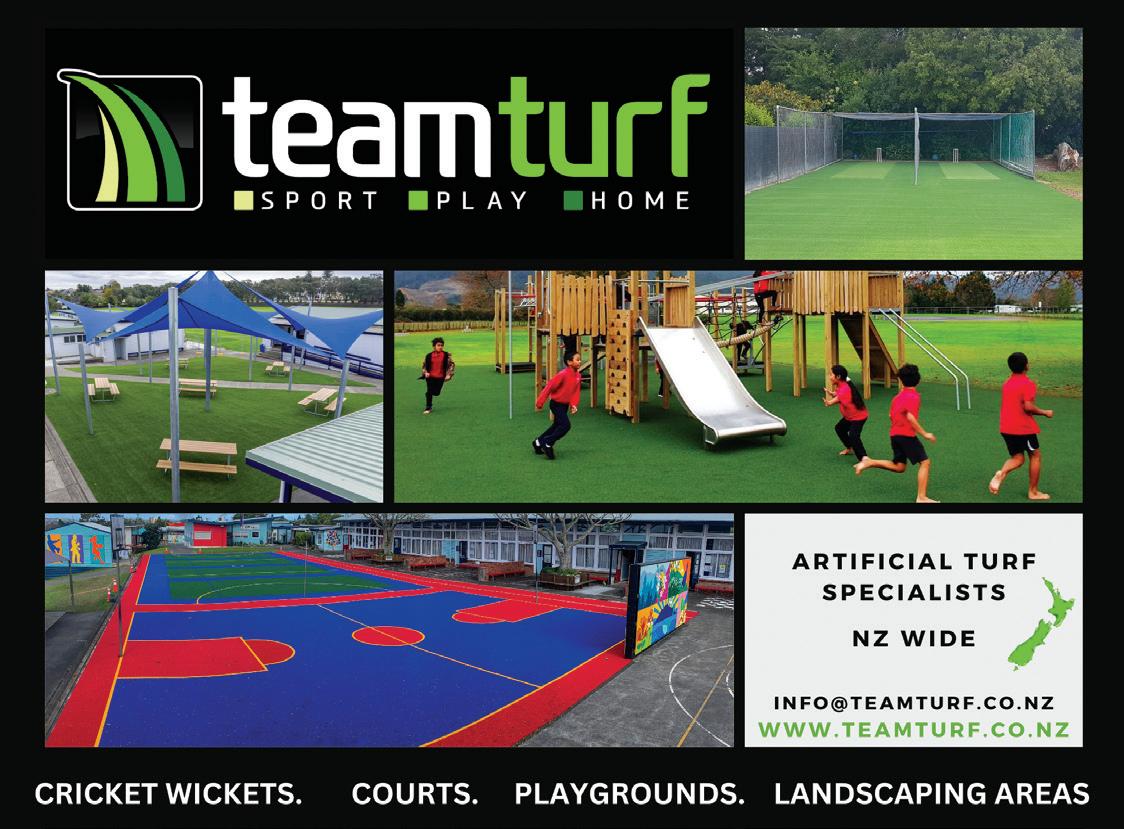


“I think it’s important for students to know you don’t have to go to MIT or whatever, you don’t have to move to the US to be a rocket scientist; you can study at the University of Waikato and stay right here in New Zealand and do really amazing, world-class stuff.”
Rose Swears
Education Gazette caught up with Dr Tisi Sharnali who is the cultural diversity facilitator at Riccarton High School, to learn more about her role in elevating cultural capability and supporting ākonga to learn in culturally sustaining ways.

Schools across Aotearoa are increasingly multicultural. This is true of Riccarton High School, in Ōtautahi Christchurch with their students representing 70 different nationalities.
To help meet the needs of each cultural group, the school hired a cultural diversity facilitator in 2018.

Today, the position is held by Dr Tisi Sharnali. Her role is multifaceted, busy, and vital. Tisi says that all schools, even if they’re not as diverse as hers, benefit from culturally capable staff like her.
“If you think about equity, schools need to give opportunities for all students to showcase their heritage culture or to sustain it in their lives.”
Tisi says students from migrant families change quickly in New Zealand schools.
“They acculturate quite fast and the school acts like a melting pot for them. They can lose their heritage culture quite fast from early learning to secondary school, and some of them will lose their language.”
She explains how it can be harmful for young people to lose essential parts of their identity, especially when they’re doing so to fit in.
“Some ākonga don’t want to bring food in their lunchbox, which is their food,” says Tisi.
“To bring equity, we need to highlight those elements so we can give [ākonga] acknowledgement that it is important to keep your heritage culture and language.”
“Just saying ‘Eid Mubarak’ to a student would mean a lot to them ... giving those little affirmations that can help the class to feel together.”
Juliet FryStudents performing with Japanese taiko drums as part of the school's annual Culture Fest.
Juliet Fry, Riccarton High School’s English for speakers of other Languages (ESOL) coordinator, says having Tisi’s vision and expertise to be able to really connect with smaller communities within their bigger community has been really useful.
These qualities have been beneficial to Riccarton’s staff, as well as students.
One key way educators can become more culturally competent lies in their perception of diversity.
Tisi says the key is not to see diversity as a challenge, but rather something that can enrich learners’ experiences in the classroom and foster a sense of community within the school.
“The class is a family,” she adds. “Nowadays, you can find information on hand. So if you want to learn about any culture, it’s available there.”
“Just saying ‘Eid Mubarak’ to a student would mean a lot to them ... giving those little affirmations that can help the class to feel together,” says Juliet.
Tisi stresses regular cultural training for all Aotearoa teachers and makes herself available to local teachers who want to ask questions about the myriad cultures at their schools.
“When you are getting students from multiple cultures, you need to make sure that you are providing something equal to any other student of your class.”
One surprising source of expertise in this area has been the students themselves.
Often, Riccarton High School students are invited to teach staff about their backgrounds and identities.
“When we have Pasifika language weeks, we have the
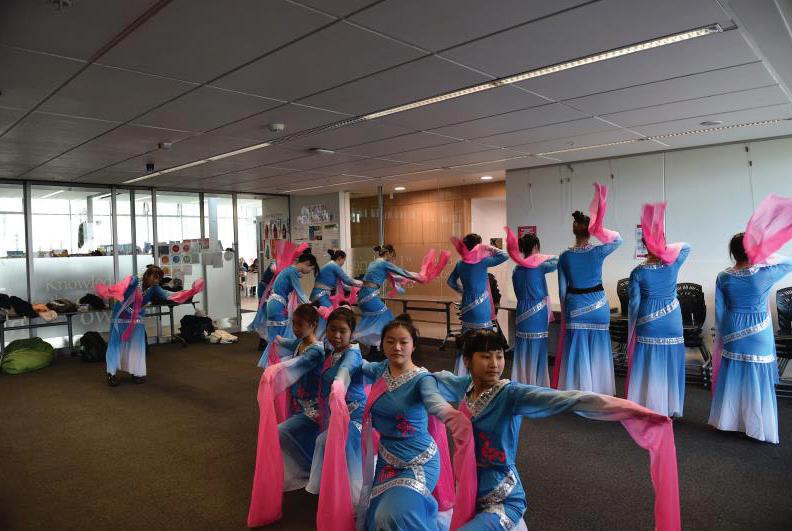
students coming into the staff room to talk with the staff, not just about language, but some of the cultural aspects of themselves. The teachers really appreciate that,” says Juliet.
Tisi says that parents can also be useful resources for teachers wanting to increase their cultural capabilities. She says, in the past, she’s had parents express a keen desire to come to introduce themselves and their child’s culture.
“Those parents, those families, they have their richness, their history. They’re bringing their history with them into the country. So we could use those families as a resource as well,” she says.
For many cultures, the passing down of knowledge from generation to generation within the same family is a vital cornerstone. Tisi says that in Riccarton’s Pasifika studies class, in particular, relatives are frequently invited to help with lessons.
When this happens, Tisi says the class becomes “a living cultural place”.
“It’s working in the ways of the cultures taught in that class, and so that’s a good model for the rest of us to use.”
Both Tisi and Juliet agree that empowering students to share and feel pride in their culture is crucial to their wellbeing, as well as the health and vibrancy of the school. Teachers play a vital role in facilitating this.
By viewing diversity as an opportunity to broaden their minds as well as those of their ākonga, educators can deliver equal opportunities to all students while facilitating an inclusive, cyclical kind of learning that gives back to all those who participate.
Juliet and Tisi share their top tips and suggestions to help elevate cultural capability and responsiveness.
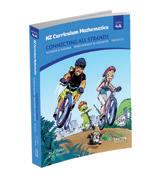
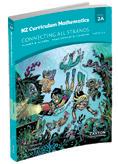
» Form a Cultural Diversity Communication Team. This could be a group of school staff who meet regularly to plan and discuss cultural diversity activities. The team should have some student representatives who give ākonga voice to the team.
» Enable active connection with whānau from ethnic communities. For example, organise ethnic parents’ meetings, celebrate ethnic events, do house visits, have school staff attend community hui and prepare a customised calendar for cultural diversity activities.

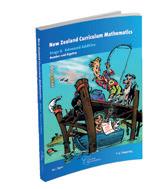
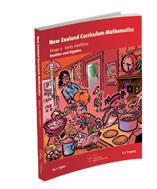

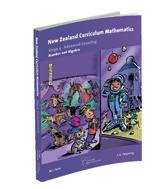

» Connect with local agencies who run various multicultural programmes and activities. Negotiate, and bring those opportunities for the students and parents.
» Make use of ethnic parents' knowledge as resources for classroom learning. Make space for them to introduce themselves and their child's culture.


» Employ a cultural diversity facilitator/coordinator who is responsible for coordinating activities



This person would have structured networks to ensure that activities are connected across the school and responsibilities are shared. Structured networking could include: regular meetings with the appropriate senior leadership person, timetabled connection with HOD of English as an Additional Language, shared responsibility for supporting former refugees, responsibility for the Cultural Diversity Communication Team.
Give
More than 600 educators from 15 countries and over 150 schools gathered at Westlake Boys’ High School in Auckland during the July school holidays for the 2023 IBSC annual conference.
For only the second time, the International Boys’ Schools Coalition (IBSC) has held their annual gathering in Aotearoa. The global organisation has about 280 member schools who share the goal of developing and educating boys.
The theme of this year’s conference was ‘Kia Moemoeā: Dream Beyond Limits’, which aimed to motivate educators to develop and encourage boys to feel connected and engaged in their learning and with their community.
New Zealand’s 47 boys’ schools represent an unusually high proportion of single-sex schools globally, says David Ferguson, headmaster of Westlake Boys’ High School.

“We’re all trying to help our boys become terrific men when they leave school. And we can all learn a lot from
each other. It’s not a competitive group: it’s a collegial, collaborative group. And the conference enables us to hear from other educators from all over the world who are dealing with the same things and the way in which they’re doing the best job they can in their own boys’ schools,” he told conference goers.
Keynote speakers included Sir Ian Taylor, who spoke about STEM (science, technology, engineering, maths) and digital opportunities, and Sir Graham Henry, who spoke about the culture of leadership.
More than 100 workshops were held during the fourday conference on a wide variety of topics including: engaging boys; creating a climate of empathetic learning; enhancing the teaching and learning of maths; recognising indigenous voice in boys’ education; growing respectful relationships, and disrupting masculinity to promote gender equity.
The conference was an opportunity for educators and leaders from boys’ schools from around the world to learn and network.

“We’ve been talking about both celebrating the strengths of boys’ schools and recognising the power that boys’ schools have in the lives of boys. And also looking at the challenges that are faced in education generally, but most particularly for boys’ education,” said Susan Hassall, headmaster of Hamilton Boys’ High School.
She said that boys’ schools in New Zealand are blessed by being progressive as well as traditional and that two real strengths of boys’ schools are character values and high expectations.

“There’s that strong sense of family and brotherhood and the fact that boys’ schools still offer a wide range of sporting opportunities. So, any young man has got the potential to be excellent and that flows back into the classroom. He’ll succeed academically as well because he feels connected and successful.
“It crafts that sense of belonging and contributing to something bigger than themselves. That’s a huge part of what the boys’ schools movement is all about, that boys are giving to something that’s bigger than themselves.”
Chris Post, chairman of the IBSC board and headmaster at The Boys’ Latin School in Maryland, USA, agreed with Susan about the unique value of boys’ schools.
“I think for boys in schools today, there are so many societal messages that are negative. The context is one in which we know that outcomes for boys, by and large, are declining. There’s not the attendance in college persistence, unemployment rates, mental health issues and all the rest.
“Boys’ schools offer a very different perspective – a hopeful, optimistic perspective. That’s the opportunity that boys’ schools and their educators have, and we never take it for granted. It’s incredibly humbling to be able to do this work,” he said.
“It crafts that sense of belonging and contributing to something bigger than themselves. That’s a huge part of what the boys’ schools movement is all about, that boys are giving to something that’s bigger than themselves.”
Susan HassallDelegates thoroughly enjoyed the conference programme. The conference theme was ‘Kia moemoeā – Dream Beyond Limits’.
Surendra Kulkarni, director of Mayo College, Rajasthan, India was himself an alumnus of his 150-year-old boys’ boarding school. He said that while the focus of the conference was on professional development, it was also a valuable opportunity for educators to learn about boys’ education in different cultures and countries.
“The discussions that go on outside of the formal sessions are often very useful and informative with perspectives from different cultures and different parts of the world. India itself is a very diverse country, and my conversations in the last three days here, have revealed that people are curious to know about India, but very few are truly aware of it.
“So, the need for much more interaction between schools, all over the world, would be very useful to understand how boys grow into men in the current context, in a very fastchanging and challenging world,” said Surendra.
He pointed out that, with the large Indian diaspora, many CEOs of international corporations have Indian roots, which is an example of why it’s important that today’s students have interactions across cultures to ready them to face the world of tomorrow.
“At the functional level, it’s very important that people have an intercultural understanding and intercultural respect, and the ability to leverage each other’s values and talents in a manner that benefits the whole.”
Research is a key focus for IBSC, with around 40 researchers presenting their findings at the conference. This provided an opportunity to discuss and explore research and best practice to empower boys to be thought leaders in wellbeing, technology, diverse learning environments, resilience, and collaboration.

The Association of Boys’ Schools of New Zealand (ABSNZ) has been collating comparative data for the past 12 years and the latest report collated achievement rates for NCEA, UE and international qualifications from approximately 155,000 male school leavers between 2017 and 2021. The data was collected from Education Counts in 2023 and compared achievement rates between male students at boys’ schools and those at coeducational schools.
The report found that, compared to boys from coeducational schools, male school leavers at single sex schools:
» had higher achievement rates across all qualifications
» had higher achievement rates across all ethnic groups
» had higher achievement rates across all deciles, although some socioeconomic effects lessened the single-sex school advantage.
The report notes that more investigation is required, as the data doesn’t show the possibility that the higher achievement rates may be affected by aspirational parents and students favouring some single sex schools because of their reputation for excellence.
“Being a head of a boys’ school is a privilege and it’s easy, because the boys come with you. I think that’s our strength,” concludes Susan.
“More interaction between schools, all over the world, and those from India, would be very useful to understand how boys grow into men in the current context, in a very fastchanging and challenging world.”
Surendra KulkarniWorld-class speakers covered a range of topics.
Ideas were discussed further over lunch, served by Westlake Boys’ students.
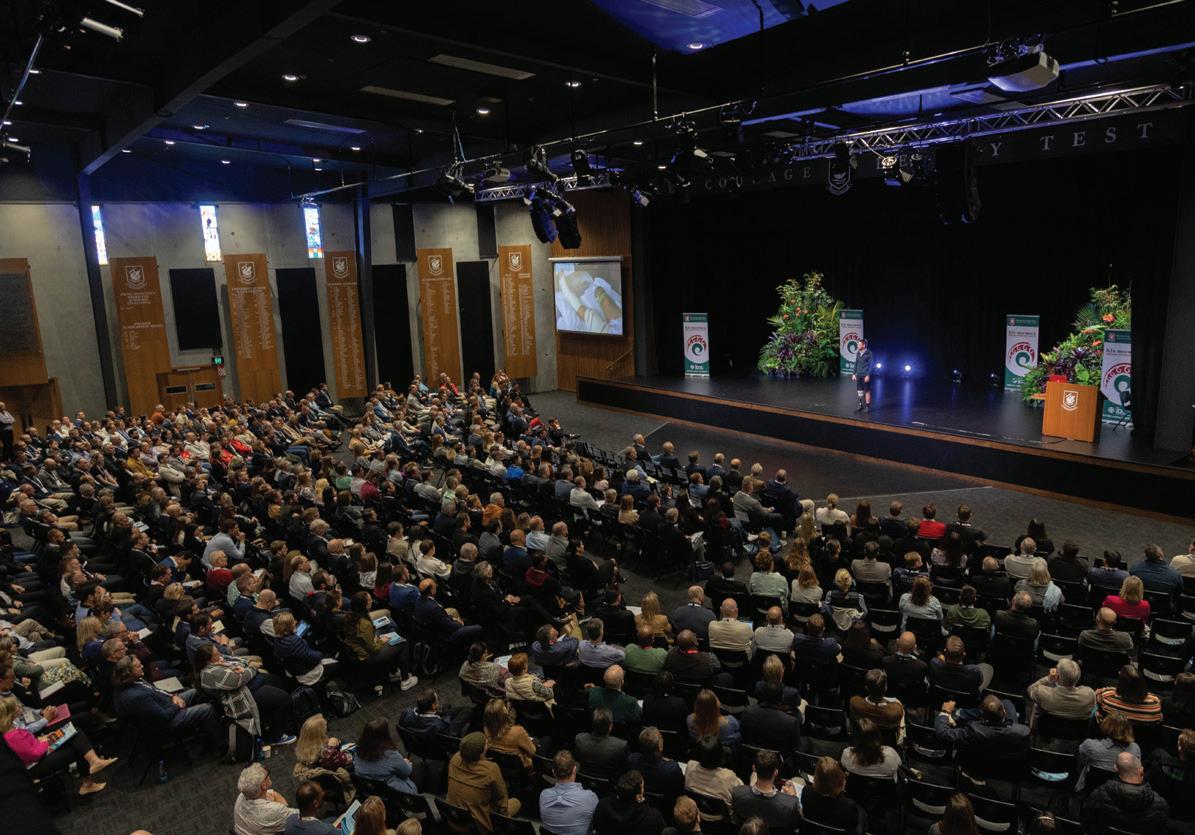
 Plenary speakers delivered their message to all delegates in the school’s Auditorium.
Plenary speakers delivered their message to all delegates in the school’s Auditorium.
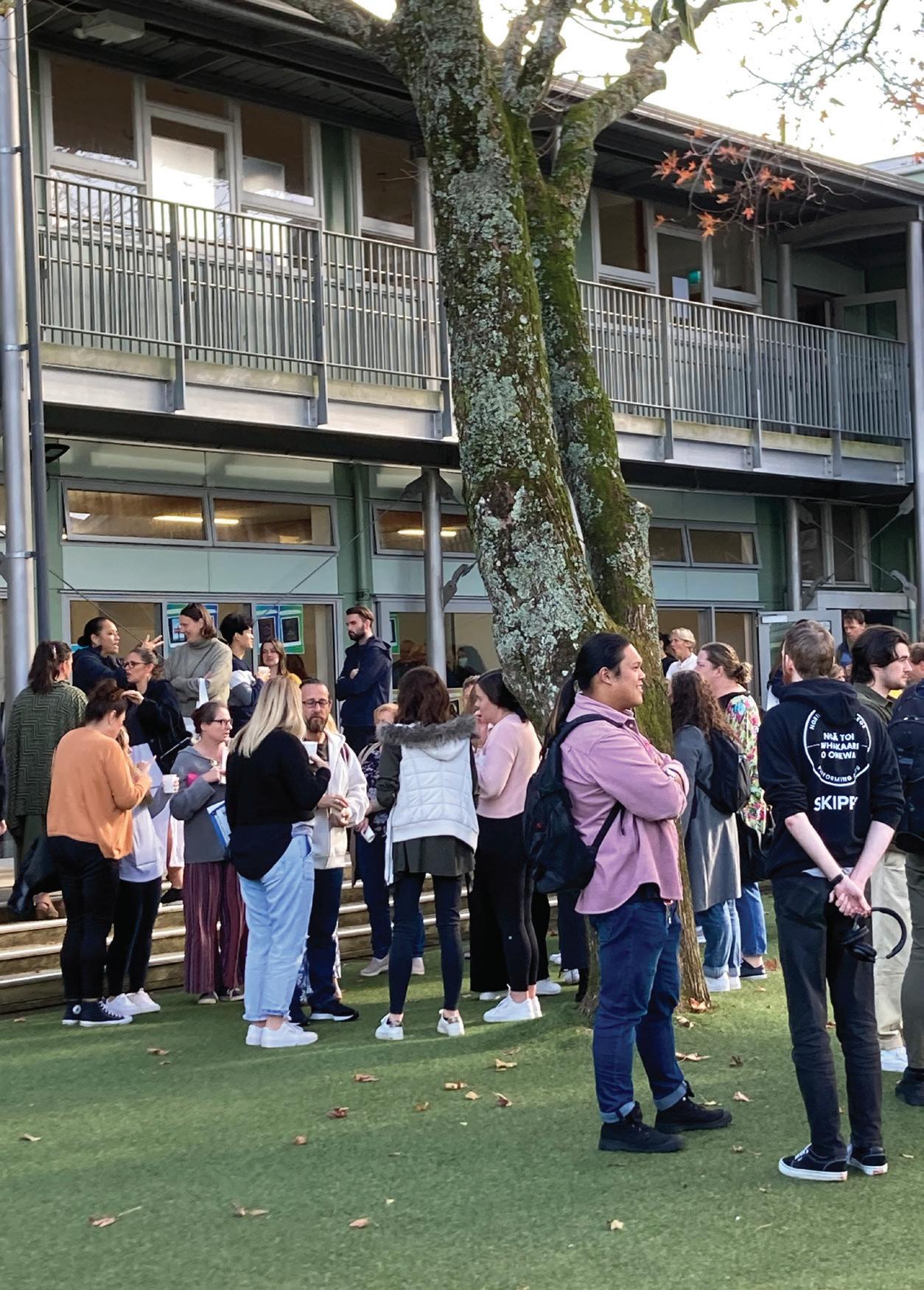 Left and right: Educators enjoyed breaks in the natural settings of Northcote College grounds during their kāhui ako teacher-only day.
Left and right: Educators enjoyed breaks in the natural settings of Northcote College grounds during their kāhui ako teacher-only day.
Education Gazette has covered several kāhui ako teacher-only days this year, and a common theme has been the value in bringing early learning and school communities together.
Northcote Intermediate principal Phil Muir, who, alongside his team, recently organised a teacher-only day for the Northcote Kāhui Ako, reiterates this, saying, “Professional development plays an important part in keeping our teachers connected, current, motivated and focused.”
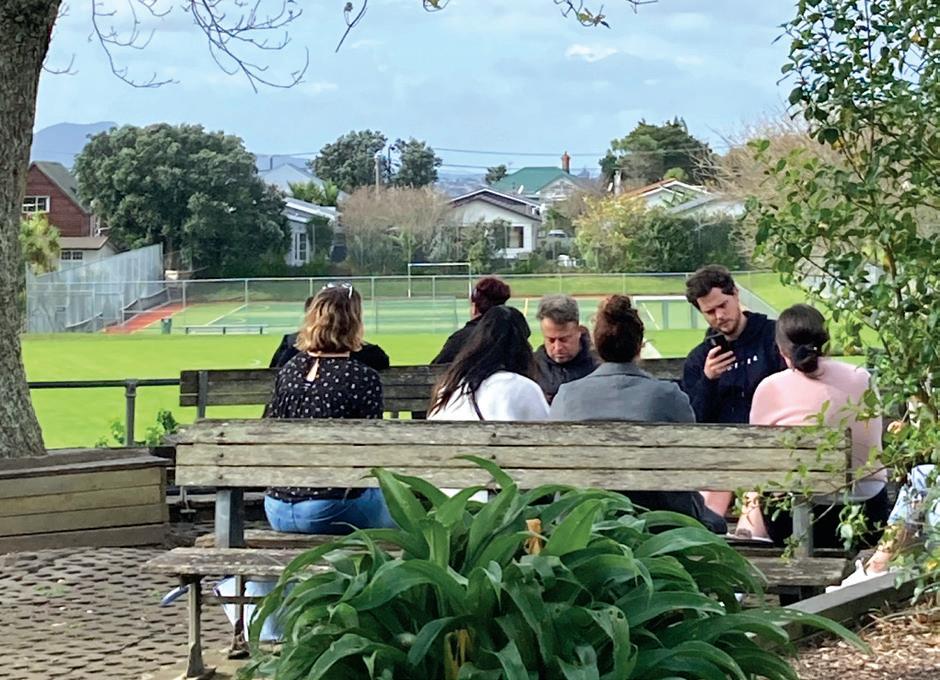
Asense of belonging was felt from the outset of a Northcote Kāhui Ako conference in June, with its focus on ‘Engaging all Learners’.
International sports performance coach and bestselling author Owen Eastwood engaged all educators with his opening keynote presentation, delivered via live link.
Setting the tone, Owen drew on his knowledge of the importance of belonging and organisational culture, as
shared in his global hit book, Belonging, to welcome teachers and education professionals to the first-ofits-kind event for the kāhui ako. Previous iterations of professional learning and development within had taken place remotely, due to the Covid pandemic.
Northcote Intermediate School principal Phil Muir and his team organised the conference, held at nearby Northcote College, to wide praise from attendees.
“I think it’s a great example of a kāhui ako



working together, as well as having a fantastic range of outstanding speakers and so many workshops – 24 in total,” says Phil.
“We’ve had so many topics covered including learning support, AI, the importance of belonging, structured literacy, mathematics… the list goes on!”
The event’s three keynote presentations provided time for attendees to come together for shared learning, with a healthy array of breakout workshops spread throughout the day.
Mental health education and hauora was provided by Abbe Waghorn from the Sir John Kirwan Foundation’s ‘Mitey’ programme. Educators were energised with interactive workshop sessions aimed at ‘reframing thoughts on supporting students’.
Massey University’s Sally Clendon presented sessions on ‘Literacy for all’.
“Literacy is such a hot topic,” said Sally, who also has a child at the Northcote College host school.
“We are making sure we are looking at all learners when it comes to literacy, and this includes considering children with complex needs.”
Learning support coordinator Helen Morris loved the fact that she didn’t have to travel far to access this wealth of professional development.
“It’s great to come together as a community again,” she said. “We often think of our community as being our own school, but it’s good to remember and experience being part of a larger community of schools.”
The event saw more than 240 secondary, intermediate, primary and early learning teachers come together. Energy was provided via a colourful, quality spread of kai prepared by Northcote College senior students.
Frances Kluge, the teacher in charge of food technology and hospitality, was delighted to see the mahi of her cohort being enjoyed and discussed by attendees, with students serving their dishes personally and enjoying warm praise.

“Everyone is doing engagement differently. It would be wrong for schools to have the same engagement methods. In schools that deliberately consider the need to build relationships, engagement is working well.”
Brenda McPherson
“We offer a Year 12/13 professional cookery option – our students love it! They have been working hard in class and cooking at lunch times. They’ve done themselves proud with what they’ve produced today and how they’ve gone about it.”
Facilitated by educational experts across a raft of engaging topics, interactive workshops included an eyeopening session from educational technology trainer, Nicole Brown. The self-titled ‘Sciwi’ (Scottish Kiwi) delivered sessions focusing her lens on the use of AI in the teaching profession.
Nicole shared her insights and experience on the benefits of Artificial Intelligence capabilities for teaching and learning. Her sharing on the potential use of AI to assist teachers with lesson planning and student reports grabbed the attention of workshop participants.
Nicole employed real-time AI tech during her session, with live caption translation from English into te reo Māori, to demonstrate one of the many multitudes of AI’s capability. Her spoken words immediately appearing on screen in te reo, she said, “I’m passionate about AI. I know not everybody is. But AI is for everyone; it’s low entry, high ceiling.”
Outlining the opportunities AI presents the teaching profession in terms of assessment marking, lesson planning and developing personalised learning tools, Nicole acknowledged the pitfalls of the highly intuitive technology, conceding students could potentially manipulate the technology to their advantage.
“Whatever technology develops, students will probably find ways around it,” she said.
Nicole informed participants of the Google Classroom upgrade available, which offers additional AI benefits to the standard offering, with an extra licence. She explained features such as ‘practice sets’, which give students answers to questions straight away, enabling immediate reflection and learning. ‘Read along’ provides an insights dashboard that enables educators to see how many guesses a student has had to achieve the correct answer to a question, for example.
Nicole discussed ChatGPT’s capabilities and limitations, saying, “ChatGPT input determines the detail
of its output. It doesn’t have pedagogical knowledge or teaching experience.
“You could, for example, ask it to produce 10 questions that show students’ comprehension of chapters one to three of the novel, Wonder, that align with Te Mātaiaho | the refreshed NZ curriculum, in language suited to Year 5 students. It’s that good.”
Met with a range of knowing nods among some open mouths, reactions suggested this knowledge is already being used by some, and was new information welcomed by many.
Addressing concerns around the potential AI takeover, Nicole summarised, “AI won’t replace you in the classroom but someone who uses AI will.”
University of Canterbury’s Jennifer Pearl Smith provided an overview of Hikairo Schema for primary and Te Kura Tapa Wha, before leading workshop sessions delving into how educators enable students to develop a stronger sense of identity and belonging in a te ao Māori context.
Māori Achievement Collaborative’s (MAC) Brenda McPherson looked at the ways teachers can engage students, in line with the conference theme, as part of her keynote address.
“Knowing their students, we’re asking ‘What more can teachers be doing to build relationships with these students and their whānau?’”
A former principal at Windy Ridge School for over 10 years, Brenda has been with MAC for more than four years and her keynote speech provided an opportunity for educators to reflect on their level of engagement with all learners.
“Everyone is doing engagement differently,” she said. “It would be wrong for schools to have the same engagement methods. In schools that deliberately consider the need to build these relationships, engagement is working well.”
She added that the focus at MAC is on better engaging Māori learners to improve outcomes. But the strategies used often translate well across many cultures.
“We are seeing some really exciting engagement initiatives being used by schools across our region, which runs from the [Auckland] Harbour Bridge to Wellsford.”
“We often think of our community as being our own school, but it’s good to remember and experience being part of a larger community of schools.”
Helen Morris
 A wealth of information was on hand at the Northcote Kāhui Ako teacher-only day.
A wealth of information was on hand at the Northcote Kāhui Ako teacher-only day.
A series of reports and webinars has been released to share the findings of the latest Growing up in New Zealand research – Now We Are Twelve.

More than 6,000 children and their families are part of Growing up in New Zealand – a longitudinal study of child development. The cohort of children, recruited prenatally in 2009 and 2010, reflects a broad ethnic and socioeconomic makeup. About every three years, the University of Auckland visits the children and their parents to gather information and build a picture of what it’s like to grow up in 21st century New Zealand.
The latest data was collected from online interviews conducted with 4,500 young people aged 12.
Now We Are Twelve provides insights into the lives of the young people on a range of subjects including mental health, experiences of the Covid-19 pandemic, ethnic identity, gender identity, housing, and hardship.
In June, Education Gazette attended a webinar on food insecurity and school engagement in which Dr Sarah Gerritsen, senior research fellow and lead author of the food insecurity research, discussed patterns of food insecurity and the role of school food programmes for this 12-year-old cohort.
The research team was interested in what had changed for tamariki and their whānau between the ages of eight and 12 – particularly as much of this period was during the Covid-19 pandemic.
The overall proportion of families that were food secure, or food insecure during this time didn’t change, but families did move into, or out of, food security and insecurity.
“We uncovered that government assistance is generally not enough to move families out of food insecurity. Half of families on a benefit were food insecure and 17 percent of families on benefits became food insecure over the three years between the two data waves,” explains Sarah.
The Ka Ora, Ka Ako | Healthy School Lunches programme is the largest food in schools programme, delivered to the bottom 25 percent of schools in the equity index, but Sarah says the University of Auckland research shows that 40 percent of tamariki with food insecurity weren’t eligible, or attended schools not receiving the programme.
“We recommend that the number of eligible schools is increased and that Government policy responses should be tailored to Māori and Pacific communities,” says Sarah.

Lisa Te Morenga from Health Coalition Aotearoa is not surprised that a significant number of families are still experiencing food insecurity.
“We are concerned that a number of families have problems accessing a variety of foods – which usually means they have less fruit and vegetables and healthy foods.
“Schools are helping to identify those kids in need. School lunches model healthy food and give students a chance to try new foods,” she says.
Molly Grant, research assistant and PhD candidate, spoke about some of the factors that enable school engagement, commenting that school and family contexts influence learning and engagement.
The school engagement research looked at who was engaged at school at the age of 12, how emotional engagement had changed, and the contextual factors that enhance school engagement.
Rich data was gathered from 17 questions, and a school engagement score was given to each young person. The scores ranged from one for low engagement, to five for high engagement. The average was 3.76, which showed that in general most of the 12-year-olds in the study reported positive engagement.
Key findings of the research are:
» Student-teacher relationships and students’ academic efficacy (believing in their own capabilities) had strong positive associations with school engagement.
» Cisgender girls had the highest levels of engagement. Young people who were transgender/nonbinary reported the lowest school engagement, compared with cisgender boys and girls, showing schools need more support to foster inclusive environments for all students.
» Neurodiverse young people or those with social and emotional difficulties reported lower school engagement, highlighting the need for better practices at schools for these students.
» Depression symptoms had a strong negative association with school engagement, indicating that early support for mental wellbeing is vital.
The research shows that students who report positive relationships with their teachers are more engaged in school. The research also shows the importance of students’ self-belief as learners, and the need for inclusive school environments.
Josie Tait, a lead author on the study, said, “We found that positive student-teacher relationships were one of the most important factors for young people’s engagement in school. Students were much more likely to be engaged in learning activities when they felt their teacher listened to them, helped them, respected them, and was fair to them.”
These findings highlight areas where schools and policy makers can focus efforts to promote attendance and engagement in schools.
“There needs to be a focus on building connections between teachers and students, so that students feel their unique needs and identities are respected and valued. Schools must be a place where young people feel safe, and where they can see their identity and culture reflected in their school environment.
“We’d also like to see young people getting more access to services that support mental wellbeing because we found that depression symptoms, like feeling down and feeling lonely, are associated with lowered school engagement.”
“We want all our young people to thrive. We know that, on average, more engaged students are more motivated learners, have a deeper sense of connection with school, and have better achievement outcomes,” concludes Josie.
In May 2020, 42 percent of eligible 11–12-year-olds in the study completed an online Covid-19 Wellbeing Survey as part of Growing up in New Zealand –a longitudinal study of child development.
Findings about lockdown experiences include:
» Children showed an impressive ability to adapt to new ways of life, with 64 percent still feeling connected to their school or kura.
» Some children enjoyed having increased independence, more free time and increased self-regulation in their learning.
» Device use and screen time was frequent with 76 percent of children using YouTube (most popular app) and 67 percent using devices for school or homework.
» Children in the least socioeconomically deprived areas reported the highest average screentime during the week (5 hours/day); while children from the most deprived areas reported the highest average screentime during weekends.
» Engagement with both academic and non-academic activities were key to boosting enjoyment in schooling during lockdowns.
» Experiences of remote schooling differed across demographic groupings.
» Lockdown was socially and emotionally challenging for some children who may not have received the support they required andreduced social contact may have had negative implications for mental and emotional wellbeing.
The data and Now We Are Twelve reports can be read at growingup.co.nz.
Education Gazette has covered many initiatives which address attendance and engagement, including food security. Explore the series at gazette.education.govt.nz.
New Zealand Geographic’s May/June 2023 issue focused on teenagers, which included an article looking at how some teens are managing crises such as the pandemic, climate change and cost of living.
“We want all our young people to thrive. We know that, on average, more engaged students are more motivated learners, have a deeper sense of connection with school, and have better achievement outcomes.”
Josie Tait
Have you completed the online Bus Controller training course?
Our bus controllers play a vital role in helping ākonga get to and from school safely. To help you carry out your important role, we have an online training course for all daily school bus controllers.

Even if you’ve been a bus controller for a number of years, we recommend that you complete the course – it’s a good way to make sure you are up to date with current bus controller duties and responsibilities.
About the course
It will take approximately 40 minutes to complete the course, and you can choose to complete this course over a period of time. Your progress will be saved so when you log in again you can pick up where you left off. How to access the training course
1. Go to: training.education.govt.nz
2. Login via your Education Sector Login (ESL)
3. Search ‘Catalogue’ for ‘Bus Controller’
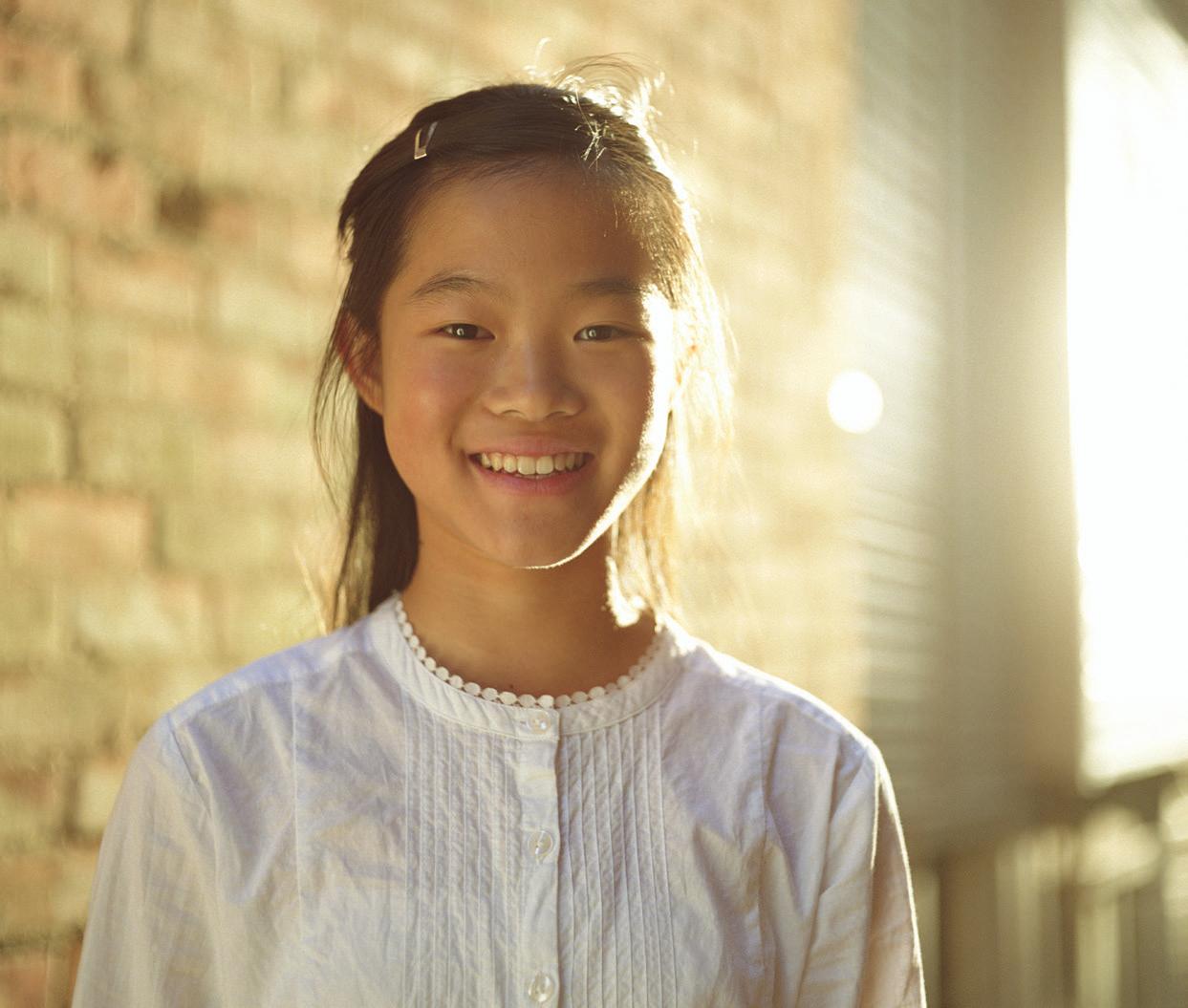
Reduce Workload and Stress (Years 11-13)
Use our Editable Assessment Masters, Internal and End of Year.
www.sincos.co.nz

SINCOS Mission Statement: Reducing Teacher Workload
Te Kura Kaupapa Māori o Pukemiro
E rapu ana te whānau o tō mātou kura i tētahi tumuaki hei pou whakahāere hei pou ārahi i tō mātou kura.
Me matatau te kaitono ki te reo Māori, ā, me mārama hoki ki ngā mātāpono o Te Aho Matua.
He tangata e kaingākau ana ki ngā tamariki me ō rātou āhuatanga katoa, ā, e mātau ana hoki ki te whakaako ki te taumata o te wharekura.
E noho ana tō mātou kura ki raro i ngā tīkanga me ngā kawa o Muriwhenua, ki te takiwā whānui o Kaitaia.
Ka timata te tūranga nei hei te Wahanga 1, 2024.
Ka kapi ngā tono hei te 3 karaka hei te ahiahi ā te 14 September 2023
KA TŪ AHAU HEI RAUKURA MŌ TŌKU IWI
‘I stand as an example of my people’
Ngā āhuatanga o te kura
• He kura takiwa: Tau 0-15
• Ngā tamariki: 136
• Reanga: U4, EQI 533
To request an application pack contact: Nikki Cherrington-Riley nikki@pukemirokura.school.nz
BEYOND THE CLASSROOM
Get your class to submit a 200-word article, with photos, describing their best school trip to be in the draw to win $250 for your school

The best entries will be printed in Education Beyond the Classroom, distributed to schools on 9 October
Entries close 6 September. Email entries to: jill.parker@nzme.co.nz
- Tagged
We are seeking a Principal for our small rural Catholic School. If you want to live, teach and lead in rural NZ consider South Canterbury. It is the gateway to skiing, tramping, fishing, shopping, cafés and having fun in one of NZ’s most beautiful rural environment, with affordable accommodation.
Applications close 30 August. See the online advertisement then email for an application package: jacquiduncan58@gmail.com
Scan the QR codes with the camera on your device.
Kaiarahi
Christchurch Boys’ High School

Kei te hunga e aroha nui ana ki te reo Māori me ōna Tikanga, tēnā koutou.
Kei te rapu mātou i tētahi Kaiarahi Mātauranga Māori hei Kaikawe Mātauranga Māori ki tō mātou kura, arā, ko Te Kura Kahurangi.
He tūranga pūmau tēnei e wātea ana ki te hunga kua roa nei e takahi ana i te ara o te mātauranga Māori.
Kei te kaitono te tikanga hei āhea tīmata ai te mahi, engari, me wātea te kaitono kia tīmata i te wāhanga tuatahi o te tau, 2024, I mua mai rānei, mā te whakaaetanga.
Christchurch Boys’ High School is seeking to employ a Head of Te Reo Māori. This is a full-time permanent position beginning Term 1, 2024 (or earlier if available).
The position carries 2MU and 1MMA and further remuneration is available for suitable candidates with the ability to undertake responsibility for school wide Tikanga.
Christchurch Boys’ High School currently has a roll of 1383 of whom almost 20% study Te Reo.
Applications close Friday 25 August 2023 at 4pm and must be made through:
https://schooljobs.nz/Job/Kaiarahi-Matauranga-MaoriHOD-Te-Reo-Maori/Canterbury/2847
The Boards of Trustees of St Oran’s College are looking to appoint a visionary and collaborative Principal, who has a strong commitment to both our special character and educational excellence.

St Oran’s College is a Year 7 - 13 state integrated Presbyterian girls’ school in Lower Hutt, with a maximum roll of 504 students, and an established reputation for empowering young women to be the best they can be.
We are seeking an experienced educational leader who is committed to professional learning, is positive, innovative, and well organised and who loves working with teenage girls.
How to apply
Contact Sarah Worthington, Secretary to the Board at St Oran’s College, for an Application Pack at sworthington@storans.school.nz
For more information, visit the College website www.storans.school.nz
Closing Date for applications: Monday 14th August 2023.
gazette.education.govt.nz
If your kura or school wants to run a creative project for your ākonga in 2024, apply now for Creatives in Schools in partnership with an artist or a creative professional.
To apply, visit: creativesinschools.tki.org.nz
